#with American stories focusing more on narrative closure
Note
Which character from any show or game worth a spinoff? Their character is very interesting and should have their own show or game.
…I wanna say perry the platypus but technically it already IS his (+ doof‘s and Candace’s) Show. Phineas and Ferb are less the protagonists than they are the setting for whatever is going on with those.
Also I‘m a Zelda fan so obligatory "Zelda/Ganondorf should have their own game!“ but. Playable Zelda might just be part of the regular games, and as interesting as playing a character who’s morally in the wrong and destined to lose could be, Nintendo ain’t gonna do that ever. They do bittersweet endings, not bleak. Even the two games where you nuke a whole reality still give you a "but they lived on in some way and even fulfill their dreams“. Also having character whose whole entire deal is being op af doesn’t…really sound like fun gameplay? Not unless you circle the entire gameplay around that or their strength is a thing in the background.
Ganondorf Monster Castle Management Sim when Nintendo
…anyways, have you ever seen Bandana Dee? He’s the player 2 of modern Kirby games. He’s a waddle dee, who are like the Goombas (and toads) of this series. The first time you meet him he’s a joke boss who’s just a regular enemy you can down in one hit. But he trained a lot to improve himself, and now he’s an actual character just as capable as the rest of the gang!
Granted, Bandee’s character itself isn’t the most interesting but idk, something about seeing the flagship starter enemy, the lowest of the lowest, grow to become just as bright of a star as the protagonist, the strongest of them all, is really cool. Might be nice to see that play out in a game!
It could be like Kirby but with level ups and skill points to really drive home the growth. And the levels could be more catered to his spear weapon that way, as it would be the only thing he uses. You can unlock new skills by meeting different friends along the way. A Fire Upgrade from King Dedede, Speed and Combo lessons from Meta Knight, Idk. The last level is Green Greens and you can see Kirby have his first adventure in the background sometimes and his actions change things in the foreground
Or maybe it the Kirby series‘ version of Sekiro: Shadows Die Twice lmao. Dark Souls but you only have 1 weapon. And in this case a lot more colorful and friendly. The biggest plot twist is the lack of an eldritch horror as a boss XD
#another anon ask#i once read that in Japan Theres a different focus when it comes to stories than American or western o whatever#with American stories focusing more on narrative closure#while Japanese focus more on emotional?#Idk how much truth it holds#absolutely forgot where I read it and it might’ve just been some random sourceless post#that flew around somewhere but#it’d explain the ending of the new game at least#does zellie turning back into a human make sense? Not without stretching it a bit#but MAN would that have been unsatisfying if she stayed up there#homegirl did NOT spend 2 games fighting for everything#just to get doomed into a state of eternal mindlessness for the rest of existence#they both deserve to finally get to LIVE#after a life + century full of pain
0 notes
Note
I finished the first season of Veronica Mars! And decided to stop after a couple of episodes of season 2. Idk, I guess I got tired of the lack of closure for many plot lines. The finale was interesting tho, I loved the final villain.
Share your thoughts on the show (here's supposed to be a question mark but tumblr wouldn't let me)
Hi bestie I'm sorry it's taken me so long to talk to you about this show! I'm gonna make up for taking forever by writing like, an essay haha brace yourself
I think that Veronica Mars is a good show that runs into some classic 2000s tv stumbling blocks, manages to do some things that infuriate me personally beyond reason, but ALSO manages to have some elements that are so powerful and so well executed that I'm honestly astonished it got made. These kinda peter out and become muddled over the years, but oh well, we'll always have season one <3
In brief, the 2000s messiness, in varying degrees of offensiveness to the world and to me personally:
The aforementioned plot lines that go nowhere <3
It's case-of-the-week, some cases are gonna suck! What can you do lol
The black best friend who doesn't ever really get any satisfying arcs or attention given to him as a character who contributes beyond letting our protagonist have dialogue with him rather than exclusively monologuing in voiceover
How they handle race in general ofc. Like while I think that in the actual plots of the show there are good intentions (and sometimes good material!) in depicting the racism of this insular hiarchical society, racism in the real world affects the writing by giving the characters of color very little to do, and over all they are taken less seriously by the narrative.
Veronica's rape plot line. I actually think this plot started out very strong! But the minute the show focuses directly on it the writing gets lost in the weeds of plot twists and rival love interests, and I really think the points they were originally trying to make get buried.
Deadbeat Mom ran off she's got a single dad raising her (i feel like the number of single dads in media is exponentially larger than the real number of single dads in life. it's propaganda. and its misogynistic. but I digress)
The stuff I personally hate:
The romances :) lol. lmao, even. (I would love to rant about this but I really think that's not something that deserves to be on what is currently a measured review of the show as a whole)
The stuff that's great:
The noir homage: It's just. It's so good. It's so fucking good. This is to noir detective stories what american vandal will be to true crime 20 years later. I want to give whoever first thought "hey, being an ostracized teen girl is kinda like being a hardboiled noir detective," a raise and a kiss MWAH <3 A+ for tone! Veronica lives on the edges of her society (high school), allowing her to see all of it's pieces and hypocrisy, turning her cynical and aloof. And she's a teenager who solves crimes :D She's funny and self aware of her role, but never in such a way that it feels like lampshading or winking at the audience. They take it seriously--they take HER seriously, and that makes the show work.
Lilly: The central case of the show, the murder of Veronica's best friend and Veronica's revenge-driven mission to find her killer, is where the first season gets its power. Veronica gets to have the noir detective plot line of being haunted by the death of a woman she loved and driven by revenge, and it is so much more powerful here than I've ever seen it in its original form. Lilly is a tragedy, she is an unflinching look at the sexual exploitation of teenage girls and the casualness with which violent men will turn that violence on them, she is a messy bratty bitch of a sixteen year old, and Veronica loves her. Lilly gets to be complicated because Veronica, who knew her and loves her, is telling us her story. There are a lot of people who are affected by Lilly's death, but this show is about Veronica, and her reaction to the murder of her friend is what matters to the writers and the viewers. Once again, the show takes Veronica (and her grief and her rage and her love) seriously, and there is a lot of power in that. I think the reason the later seasons struggle is because they simply can't stand up to the emotional intensity that made up the core of season one.
#here i am answering asks weeks late! MWAH babe thanks for asking me always <3#i know you're asleep lol but here are My Thoughts for when you wake up <3#if you are willing to sit through my Complaints About The Romance In Veronica Mars send me a dm or another ask or something haha#i love talking about it but i think it would be unfair to put in like an overall review of the show?#we are Serious Bloggers here we present unbiased opinions of television shows from the 2010s#just went and looked up when it actually aired and wow it was 2004. a lifetime ago! wild#veronica mars
16 notes
·
View notes
Text
Thanks to Glass Onion, my partner finally got interested in Daniel Craig’s Bond, so I got to rewatch Casino Royale and Quantum of Solace.
And I am shocked how GOOD especially Quantum of Solace is?! I remember being a bit confused back then since its pacing is extremely different from Casino Royale’s, but they simply don’t waste any time with unnecessary details.
Most importantly: narrative and camera work JUST AS erratically as James’s mind in this film. The way they tell this story of revenge, and what revenge is worth, if you even need it or if you’re able to heal and forgive—it’s all as if we’re directly in James’s mind, and that’s just a brilliant piece of storytelling right there. (It’s also why the pacing takes a breather right at the end: because James has forgiven Vesper and is more focused again.)
Then, the title song alone. It calls back to Vesper’s “betrayal”, her death, and how it killed James in turn. But it also tells a story of Camille’s trauma. How she uses her own death, her pain, to exact revenge on the man who killed her family (and raped her mother and sister), who made her watch and almost burned her down with the building.
The trauma narrative! For a spy movie, it is just handled so wonderfully. Camille seizes her chance to end her tormenter’s life, but the moment she is done, the emptiness in her follows immediately, erasing all adrenaline and leaving room for a PTSD flashback that almost kills her because everything around her is burning—if James hadn’t learned by now that aimlessly killing the people involved in organization Quantum won’t bring him closure for Vesper’s death. So he DOESN’T kill Dominic Greene, but instead snaps out of it, lets him off the hook for now, and RUNS THROUGH THE FIRE TO RESCUE CAMILLE.
They literally go through fire to confront their trauma!!! I just. Damn.
Not to mention the political nuances in this. Quantum of Solace doesn’t mince words. “Oh yeah the Americans are involved in a lot of coups around the world; they don’t care whether it’s a dictator or not so long as they get their share”, AND THAT IS NOTHING BUT THE TRUTH.
I am not surprised that this movie has just around 60% on Rotten Tomatoes. Most (US) critics just can’t take the actual truth about their country. And most critics seem to have lost the ability to read between the lines and from obvious imagery.
But Quantum of Solace is just a brilliant Bond movie. Perhaps not as rattling as Skyfall (can’t wait to be destroyed by that one again), but it deserves way more credit than it got. You just have to have a quick mind with this one. Because James Bond won’t wait for you to catch up with him.
25 notes
·
View notes
Text

I posted 568 times in 2022
That's 160 more posts than 2021!
197 posts created (35%)
371 posts reblogged (65%)
Blogs I reblogged the most:
@emilreloaded
@powerfromthegreenwitch
@taskmastercaps
@simzart
@u3pxx
I tagged 311 of my posts in 2022
Only 45% of my posts had no tags
#quotations - 176 posts
#mo xiang tong xiu - 21 posts
#moby dick - 20 posts
#herman melville - 19 posts
#gene wolfe - 17 posts
#grief - 15 posts
#ace attorney - 14 posts
#megan whalen turner - 11 posts
#maggie stiefvater - 10 posts
#heaven official's blessing - 10 posts
Longest Tag: 140 characters
#the evolution of i'm not sure if good omens 2 is a good idea without terry pratchett to oh john finnemore is involved this will be wonderful
My Top Posts in 2022:
#5
"(...) When you gone to get married? You need to have some babies. It'll settle you."
"I don't want to make somebody else. I want to make myself."
Sula, Toni Morrison
24 notes - Posted July 29, 2022
#4
He was daydreaming, and his thoughts, moving like the sea, gradually turned from the rhythm of the waves to that of the long, slow passage of time, and hence to the inevitability of growing old -- and he suddenly caught his breath. He had never looked forward to the wisdom and other vaunted benefits of old age. Would he be able to die young -- and if possible free of all pain? A graceful death -- as a richly patterned kimono, thrown carelessly across a polished table, slides unobtrusively down into the darkness of the floor beneath. A death marked by elegance.
The thought of dying suddenly spurred him with a desire to see Satoko, if only for a moment.
Spring Snow, Yukio Mishima
28 notes - Posted May 25, 2022
#3
I responded to back-to-back trauma by writing fanfic for the first time in ... 15 years?
Since people are returning to tumblob for Reasons, maybe it is a good time to promote my current creative outlet and maybe we can do it without being self-depreciating!
I’ve been writing Ace Attorney fanfic, specifically focused on Apollo Justice. In chronological order, because all things are linked in my brain:
Camouflage; or A Field Analysis of the Habits and Disposition of the Average American Teenage Boy: Apollo and Clay have a sleepover in high school. About being a teenager and forming friendship bonds and parental loss.
Begonia, Bittersweet: post-Apollo Justice: Ace Attorney, Apollo visits Vera Misham in the hospital to have a circuitous talk about forgery and victimless crimes.
The Normalacy of Grief: post-Ace Attorney: Spirit of Justice, Apollo, Nahyuta, and Rayfa talk about dead dads.
Snatching Closure from the Jaws of Chaos: hey you know how Shu Takumi left the series after Apollo Justice: Ace Attorney and the games that followed it that weren’t by him seemed to drop a lot of things that could have used further exploration?
*Citation Needed: WIP about Klavier visiting Apollo in Khura’in after the above story. There’s kissing. Hypothetically. Eventually. AND dead bodies. Eventually.
Lanugo: formerly amnesiac mother has some complicated feelings about meeting the son she thought was dead and then was amnesiac about with both of them knowing who the other is.
Missing You/Missing Time: some mystical bullshit goes down while Apollo and Klavier are juggling a long-distance relationship and it sucks and everyone hates it.
WE WILL NOT MAKE THE SELF-DEPRECIATING COMMENTS TO CLOSE OUT THIS POST THERE ARE SOME STORIES I HAVE WRITTEN THEM YOU CAN READ THEM PEACE.
73 notes - Posted November 14, 2022
#2
This seemed to resonate with some folks on the other social media site
Also now reading "Moira's Pen" (2022) by Megan Whalen Turner because I'm not taking "The Odyssey" into the bath to be dropped by my tiny hands.
You would think that a collection of short stories - although it's not really that (errata maybe) - published after the conclusion of an author's series would be full of answers to narrative gaps, things readers have always been curious about, elaborations from the ending.
So I'm absurdly pleased that Turner continues to answer basically no questions beyond "what is the age difference between two characters?" and "who is Gitta?" and instead has scattered dozens of new questions for the reader.
I might have further thoughts in terms of how this all fits with Turner's approach to series structure as a whole because I continue to find that fascinating. If I don't, though, cheers for more material confirming Relius as the least wholesome queer character. What a gift.

See the full post
96 notes - Posted October 25, 2022
My #1 post of 2022
"Li Shimin." Gao Qiu plants his elbow on the golden tablecloth and points at Shimin, designed black robes gleaming with a leather shine. "We barely have to do any rebranding for you. You're the baddest of bad boys. The ultimate alpha male. You live by your own rules, not giving a fuck about what other people think, and that's exactly what makes you so alluring. Men want to be you; women want to be protected by you."
"Um," Shimin says. "Okay."
Iron Widow, Xiran Jay Zhao
903 notes - Posted April 16, 2022
Get your Tumblr 2022 Year in Review →
#tumblr2022#year in review#my 2022 tumblr year in review#your tumblr year in review#2023 predicted to be more of the same
0 notes
Note
why are you against the use of the term anthropocene
Well, I’m not totally against its use; I think it can be useful, especially in discussions in popular mediums outside of academia. But I do think that academic discussion of and much of the popular discourse around and involving that term, especially among Euro-American scholars, is Eurocentric and pedantic. Eurocentric, in the sense that the discourse ignores Indigenous criticisms while simultaneously appropriating Indigenous cosmologies and accepting funding/concessions from (neo)colonial institutions. Pedantic, in the sense that the discourse is too focused on finding a specific start-date; too focused on fossil fuels and not enough attention is given to the arguably more-influential role of industrial-scale agriculture throughout human history; and not enough discussion of the human institutions (social hierarchies built to facilitate empires and resource extraction) that inflict social and ecological destruction. I do sometimes like the term as a rhetorical device, but prefer terms like “Plantationocene” which are more specific about which institutions and imperial cosmologies are most influential in provoking both violence against humans and ecological change and apocalypse.
You have probably heard of alternate proposed names for the same era of human influence: Plantationocene, Capitalocene, Cthuluscene. I agree that the distinction matters, and many people (especially Indigenous people and others from Latin America and the Global South) have written about the importance of this name. Indigenous writers and scholars have, in my opinion and not surprisingly, offered the most biting criticisms of Anthropocene discourse. From the perspective of North America, I enjoyed the writing of Dwayne Donald (Papaschase Cree); Zoe Todd (Metis); Kali Simmons (Lakota); and Kyle Whyte (Potawatomi); all of whom write explicitly about the Anthropocene, the ethics of ascribing a name to this era, its Eurocentric discourse, and alternative Indigenous interpretations of global environmental history. And if my rambling is annoying and if this post seems too absurdly long to read, then I would recommend reading what Zoe Todd has written about the importance of how the name of the era influences narratives told about human social and ecological stories; she also addresses other shortcomings and Eurocentric aspects of the Anthropocene concept: Heather Davis and Zoe Todd. “On the Importance of a Date, or Decolonizing the Anthropocene.” December 2017.
—–
Here’s how I feel about the term “Anthropocene”:
Assuming we agree that the intertwined forces of colonialism, imperialism, industrial-scale agriculture, resource extraction generally, and the hierarchical social institutions which support them (including forced labor, severance of community connection to ecosystems through closure of the commons, racial and gender hierarchies, and Indigenous dispossession) are basically the major influences on global ecological change now and over the past few centuries or millennia (including the present-day, the era of overt European colonization across the globe, and earlier manifestations in historical “classic” state-building and early ancient hydraulic civilizations): Instead of looking for a specific date sometime around 1822 in Europe when fossil fuel emissions scarred the soil, like a technical geologist might, I instead try to ask at which point industrial-scale resource extraction (especially including agriculture and deliberate devegetation campaigns even in its ancient manifestations), supported by and to the benefit of social hierarchies and imperial worldviews, begin to alter soils at vast continent-wide scales enough to be the planet’s leading driver of change in soils, vegetation, oceans, and atmosphere?
Did it begin with the advent of industrial specialist guilds in Mesopotamia, when kings would bribe irrigation engineers not to help a farmer water their fields until the farmer had paid tribute or rent? Did it begin in Zhou-era or Warring States period China when deliberate devegetation campaigns, large forest-clearing projects, and flood-prevention dam infrastructure installation led to local extinction of tiger, rhinos, and elephants? Rome? The Columbian Exchange, institutionalized slavery, and plantations in seventeenth-century European colonies in the Americas?
Is an Isconahua community in Amazonia’s forests equally as responsible for global ecological change as a multi-billion-dollar American mining corporation?
This is an example of what might be the most common criticism of the term: The Anthropocene term, by invoking “anthropos,” is imprecise because rather than identifying the actual source of global ecological change (certain systems, institutions, and practices) it implies that blame be ascribed to humans-as-a-species for provoking this global ecological apocalypse. This criticism (”Anthropocene obscures responsibility”) is just one of many.
These are probably my major issues with Anthropocene: (1) According to Indigenous scholars and many writers from the Global South and especially Latin America, the name obscures responsibility and doesn’t adequately imply which human systems and institutions are responsible for global ecological catastrophe, erasing and obscuring the ongoing violence which those same institutions continue to enact, both upon ecosystems and human lives. (2) And given geologists’ common focus on fossil fuels as the key indicators of Anthropocene start-date and human influence on environment, I think that this distracts from the arguably more influential and more important role of agriculture (and associated devegetation for purposes of settlement, rangeland, etc.) as perhaps the more dramatic human influence on global ecological history. Fossil fuels didn’t kill the bison and change the entirety of the Great Plains from boreal climates to the subtropics. Empires seeking resource extraction, accomplished through violence and dispossession, killed the bison and changed the continent. (3) The concept is the result of Euro-American academic discourse and does not adequately incorporate Indigenous and non-Western criticisms. And while paying superficial lip-service to “decolonization, the same academic departments maintain relationships with (neo)colonial nonprofits and government agencies while the discourse also simultaneously engages in continued appropriation of Indigenous concepts. (4) Finally, if we agree that industrial-scale resource extraction (including agriculture) and its associated social institutions are (or at least were, for most of the past) the major human influence on altering ecology, then assigning a specific start-date is extremely difficult and probably just an exercise or thought experiment, because at what point in history did these extractivist cosmologies reach “critical mass” and become the leading worldview through which (some) humans disproportionately exercised so much power over altering landscapes?
—–
I’ll recycle something I’ve previously said:
“Did the Anthropocene begin in 1821, or 1822? Did the year 1821 mark the definitive shift into a global expansion of urbanization and monoculture plantation crops, or was it the year 1822?” These are, to some degree, technicalities. This is not, or should not, be the point of “Anthropocene.” I mean, it is often important to know some specific dates; like the specific date that Russian settlers first encountered Steller’s sea cow; the specific date that English authorities issued permits for corporate monopolies on guano trade in Peru; the specific date that deliberate fire-setting dispossessed Indigenous people in Borneo and signaled arrival of palm oil plantations; the specific dates that certain agricultural, colonial, and imperial institutions invaded, expanded, or consolidated their power. But “the single date when imperial cosmologies achieved critical mass as the dominant ecological force”? I think that’s more ambiguous.
I appreciate that some popular venues or forums like academia, occasionally, are at least attempting to openly discuss a 12,000-year-old trend towards imperial power consolidation which relies on social hierarchy, disconnecting communities from local native species and landscapes, Indigenous dispossession, and the commodification of ecological systems. Glad it’s being discussed. But the discourse has issues and I think we can do better than “Anthropocene” as a term. Even if we treat Anthropocene more like an informal thought experiment, and improve it by renaming it “Plantationocene” or something, I still don’t think formally defining a specific date or “Day 1 of the Anthropocene” is as important as clearly identifying which systems and institutions actually provoked centuries of dramatic ecological change and the current ecological collapse. I think that identifying a technical start-date for a geological epoch is comparably a distraction from the discussion of ecological degradation and extinction; a distraction from the concept’s implied-but-inadequate criticism of imperial cosmologies; and a distraction from how global ecological collapse and crisis is closely related to and deeply intertwined with social hierarchies, institutions, and violence against other humans.
–
Thank you for the question :)
251 notes
·
View notes
Text
The Psychological Needs That QAnon Feeds
Joe Pierre M.D.
Psych Unseen Psychology Today
Part 1: What to do when someone you love becomes obsessed with QAnon.
August 12, 2020
“Where we go one, we go all.” — QAnon mantra
Ever since I started writing about conspiracy theories, readers have occasionally written in to ask for advice about a family member who has fallen down the rabbit hole of belief. To be honest, beyond expressions of sympathy and referring them back to my posts about why people are attracted to conspiracy theories in the first place, I often feel at a loss to offer anything helpful. The stark reality is that becoming obsessed with conspiracy theory beliefs has significant potential to drive a wedge between loved ones that can irreparably damage relationships.
Recently, however, I was invited on KQED radio to talk about this issue as it relates to QAnon, which prompted me to consider a more thoughtful response that I’ll cover here in a series of blog posts.
In Part 1 of this series on “What to Do When Someone You Love Becomes Obsessed with QAnon,” we’ll explore why it is that some people are so drawn to QAnon. Understanding that is a vital starting point if we hope to help loved ones climb of out the QAnon conspiracy theory rabbit hole.
Understanding the Psychological Needs That QAnon Feeds
QAnon is a curious modern phenomenon that’s part conspiracy theory, part religious cult, and part role-playing game.
Some of the psychological quirks that are thought to drive belief in conspiracy theories include need for uniqueness and needs for certainty, closure, and control that are especially salient during times of crisis. Conspiracy theories offer answers to questions about events when explanations are lacking. While those answers consist of dark narratives involving bad actors and secret plots, conspiracy theories capture our attention, offer a kind of reassurance that things happen for a reason, and can make believers feel special that they’re privy to secrets to which the rest of us “sheeple” are blind.
With an invisible leader (it’s not even clear if “Q” is a single individual or several), no organizational structure, and no coercive element for membership (people are free to “come and go” as they please), it would be a stretch to call QAnon a religious cult. But it has been increasingly modeled as something of a new religious movement, especially inasmuch as it’s often intertwined with an apocalyptic version of Christianity. Previous research on cults has revealed that people who join them are more likely to have symptoms of anxiety and depression and are often lonely people looking for emotional and group affiliation.1 Anecdotal evidence suggests that a similar psychological profile may also account for why some might find QAnon appealing.
Beyond conspiracy theory and online cult, QAnon has also been described as “an unusually absorbing alternate-reality game” where online players who refer to themselves as “bakers” eagerly await the chance to decipher cryptic clues in the form of “bread crumbs” or “Q-drops.” These rewards are dispensed within an irregular "variable ratio reinforcement schedule" that highlights how QAnon represents an immersive form of entertainment that, like online gaming or gambling, provides an ideal set-up for a kind of compulsive behavior that resembles addiction.
The puzzle-solving, role-playing dimension of QAnon acts as another reinforcing intoxicant of sorts, providing believers with an exciting new identity as a "Q Patriot." Back in the 1980s, parents worried that kids playing Dungeons and Dragons would get so invested in their magical role-playing characters that they might lose touch with the real world. Today, QAnon is a kind of live-action role-playing game in which the conflation of fantasy and reality isn’t so much a risk as a built-in feature.
Understanding the multifaceted aspects of QAnon in this way helps to understand its appeal as well as why believers might be unwilling to unplug and walk away. For those immersed in the world of QAnon, climbing out of the rabbit hole could represent a significant loss—of something to occupy one’s time, of feeling connected to something important, of finally feeling a sense of self-worth and control during uncertain times.
Without replacing QAnon with something else that satisfies one's psychological needs in a similar way, escape may be unlikely. Of course, leaving QAnon would allow believers to reclaim significant time and energy that might be better channeled into healthier real-life relationships, work, and recreational pastimes. But for many, the very lack of such sources of meaning might have led them to seek out QAnon in the first place, such that there would be little guarantee of finding them anew.
From that perspective, life down in the rabbit hole might look pretty good. As one QAnon believer put it , “Q is the best thing that ever happened to me.”
How can we convince our loved ones to walk away from that?
For more answers, stay tuned for Part 2.References
1. Rousselet M, Duretete O, Hardouin JB, Grall-Bronnec M. Cult membership: what factors contribute to joining or leaving? Psychiatric Research 2017; 257:27-33.
https://www.psychologytoday.com/ca/blog/psych-unseen/202008/the-psychological-needs-qanon-feeds
_______________________________________
Joseph M. Pierre, M.D. is a Health Sciences Clinical Professor in the Department of Psychiatry and Biobehavioral Sciences, David Geffen School of Medicine at UCLA and the Acting Chief of Mental Health Community Care Systems at the VA Greater Los Angeles Healthcare System. His work focuses on the treatment of individuals with severe mental disorders, including schizophrenia, bipolar disorder, major depression, and co-occurring substance use disorders. Although his clinical practice centers on the care of hospitalized patients who suffer from psychotic disorders, he has a longstanding interest in the grey area between psychopathology and normality and the psychological underpinnings of everyday life. Psych Unseen draws from the perspectives of psychiatry, neuroscience, psychology, and evidence-based medicine to address timely topics related to mental illness, human behavior, and how we come to hold popular and not-so-popular beliefs.
AUTHOR OF Psych Unseen
Psych Unseen: Brain, Behavior, and Belief draws from the perspectives of psychiatry, neuroscience, psychology, and evidence-based medicine to address timely topics related to mental illness, human behavior, and how we come to hold popular and not-so-popular beliefs. Read now.
___________________________________________
Part 2 How Far Down the QAnon Rabbit Hole Did Your Loved One Fall?
What to do when someone you love becomes obsessed with QAnon,
Psychology Today August 21, 2020
Joe Pierre M.D.
___________________________________________
Part 3 What to do when someone you love becomes obsessed with QAnon
Psychology Today September 1, 2020
Joe Pierre M.D.
___________________________________________
Born on the dark fringes of the internet, QAnon is now infiltrating mainstream American life and politics
CNN July 3, 2020
by Paul P. Murphy
___________________________________________
The thin line between conspiracy theories and cult worship is dissolving
An information war is being waged.
bigthink.com May 18, 2020
by Derek Beres
___________________________________________
I’m dating a conspiracy theorist. But it feels like I’m the one going crazy.
Washington Post August 16, 2020
by Trent Kay Maverick
___________________________________________
The Birth of QAmom
Rolling Stone September 2020
by EJ Dickson
___________________________________________
Christian Groups That Resist Public-Health Guidelines Are Forgetting a Key Part of the Religion’s History
TIME
___________________________________________
The Prophecies of Q
American conspiracy theories are entering a dangerous new phase.
Story by Adrienne LaFrance
ILLUSTRATIONS BY ARSH RAZIUDDIN
The Atlantic June 2020 issue
This article is part of “Shadowland,” a project about conspiracy thinking in America.
https://www.theatlantic.com/magazine/archive/2020/06/qanon-nothing-can-stop-what-is-coming/610567/
___________________________________________
16 notes
·
View notes
Photo

Human Resources.
Kitty Green talks to our London correspondent Ella Kemp about “putting the audience in the shoes of the youngest woman in a toxic work environment” in her new film, The Assistant.
The long-undervalued job of a Hollywood assistant has come into stark relief thanks to recent events, and the stories that are being told of assistants’ experiences, working conditions and pay rates are jaw-dropping. (Episode 422 of the Scriptnotes podcast is well worth a listen.)
Filmmaker Kitty Green was well ahead of the conversation; her first narrative feature, The Assistant, quietly premiered at the Telluride Film Festival last August (and the Berlinale in February). Dubbed by many as ‘the first post-#MeToo movie’, it is a remarkable portrait of a young woman navigating just another day in the office. Except this is not just another office, and so many things are wrong about this day.
Starring Julia Garner (Grandma, The Perks of Being a Wallflower, Electrick Children) as Jane, the assistant to the predatory head of a New York-based film studio, the story zooms in on the details of her routine—the tedious tasks, the belittlement from her colleagues, the oppression from her mostly faceless boss—with such laser-sharp vision that by the end we feel we know Jane deep in our bones.
Green has previously directed the documentary features Ukraine is Not a Brothel (2013) and Casting JonBenét (2017), the latter a meta-documentary that also hones in on the neglect and exploitation of young women, albeit under a different light (it is now streaming on Netflix). While Green’s documentary experience bears fruit in her attention to detail, the narrative form of The Assistant allows for a focus on mundane tasks and micro-reactions that documentary might not have access to.
Various Letterboxd reviews mention the anxiety-inducing way The Assistant allows us to watch Jane “probe her place in the established, tacit system of complacency… knowing that everyone around her is motivated by self-interest to pretend it doesn’t exist” (Josh Lewis). “Green encourages her viewers to pay close attention to what’s really going on beneath the surface,” (KristineJean) in “a horror movie of soul-sickening ambience” (Scott Tobias).
Though The Assistant’s film festival run was cut short, and the closure of cinemas around the world hurts for a lot of us, there’s something about the claustrophobia of social distancing and the intimacy of the small screen that maybe suits this picture. Nevertheless, seeing the film in a cinema in ‘the before time’ highlighted for Alyssa Heflin the ocean of different opinions that can come from misunderstood subtext: “Watching this in a room where you can hear people snickering at the girl and asking what the point of all this is adds a certain extra… incendiary level to an already deeply angry viewing experience.” Indeed, discomfort and crossed wires seem to define the messages at the core of The Assistant.
Kitty Green talks to Ella Kemp about the influence of Chantal Akerman, the infinite watchability of Julia Garner, and the oddness of growing up with a Nazi-free edit of The Sound of Music.
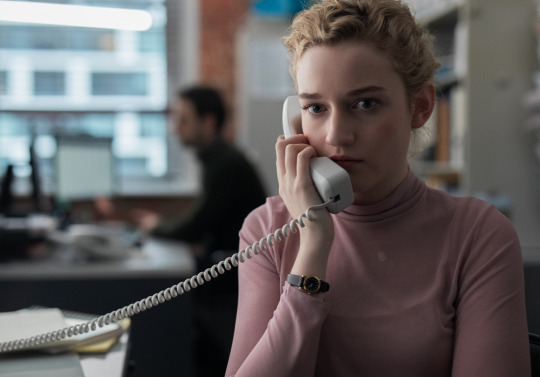
Jane (Julia Garner) takes another call from the boss in ‘The Assistant’.
The Assistant is your first fiction feature. The subject matter feels so immediate—what made you choose to not make a documentary of this, given your track record in that realm?
Kitty Green: I went to fiction film school, and I made fiction short films. I then found work in documentary, so I made two feature-length docs. With this one, I was looking at exploring the micro-aggressions, the tiny moments, gestures, looks, glances, behaviors that often go overlooked when covering the #MeToo movement. We often talk about the bad men and the misconduct, but this is more about a cultural, structural problem. So I was hoping to amplify the more quietly insidious behavior that we need to address if we really want things to improve. A fiction film allowed me to hone in on details—close up—and the way you can take an annoyance through the emotional experience, putting the audience in the shoes of the youngest woman in a toxic work environment.
How did you decide to keep the timeframe to just one day in Jane’s life rather than fleshing it out over a longer period?
The lead character is in such a complicated position. It’s such a difficult set of circumstances, the machinery that this predator has created around himself. I wanted to untick that, to discuss how difficult it is to be a young woman in that environment. So the day, the routine, was really important. What she was experiencing, how she was experiencing it; every task she did I gave equal weight to. Whether she was photocopying, binding something suspicious, you experience it as you would if you were in her shoes. That was important to me.
I had my fists clenched the whole time, when she’d be eating cereal, or washing up mugs, waiting for something awful to happen.
Totally. It’s exploring misconduct, but it’s also looking at a whole spectrum, from gendered work environments, toxic work environments, through all these environments that support predatory behavior. I was interested in what the entry points are, without conflating those issues and being able to explore all the cultural systemic things we need to unpick to move forward.
The film is so focused on Jane, played by Julia Garner. How did you choose her?
The script is pretty bare when it describes who she is, she’s just Jane. I didn’t have anyone in mind, really. I told my casting agent that we’re watching this character do the most mundane tasks, so it was important that she was striking. I said I needed someone infinitely watchable. I had seen Julia in The Americans and I remembered being struck by her, so I immediately wanted to meet her. She really understood the script, it worked out beautifully. We got to create the character together, we had a month of rehearsals where we really went through where she was emotionally at any given point, and Julia is wonderful so it was great.

Matthew Macfadyen and Kitty Green discuss a scene in ‘The Assistant’. / Photo: Ty Johnson
And Matthew Macfadyen—his character feels so crucial and his performance so pivotal, even in just one scene. What were you looking for when casting him?
I’ve been a fan of his for forever, but I hadn’t seen Succession. Apparently the character has some similarities? I’ve only watched Succession in the past week… Somebody had to send me a clip to prove he could do an American accent! Matthew really brought something to that character and took it to another level. It’s so insidious what he does. He and Julia worked so beautifully together, it just got better and better every time.
How did you feel watching Succession now and seeing Matthew as Tom Wambsgans?
Tom still feels different somehow. But I’ve had a good time watching it, he’s so great. There are parallels for sure!
The language you use in the film is so careful, so much is in the subtext. How do you build tension from these empty spaces?
We had a great visual team who were lighting it in an interesting way. There was a lot of oppressive fluorescent lights. The sound was also very important—we had an amazing sound designer, Leslie Schatz, who does a lot of Todd Haynes’ stuff and Gus Van Sant’s. He’d done Elephant, which I thought was phenomenally sound designed. He sent out a team to record every kind of buzz, hum, whir, and we created a lot of tension in that soundscape. It heightens these moments when you can really feel the hum of the fluorescent lights or the alarm of the copier. Things like that are authentic to the world, so it doesn’t feel like you’re manipulating an audience, but they do add a dramatic tension.
During The Assistant’s various film festival screenings so far, audience reactions have been quite varied. Some people find it uncomfortable, some have found it funny. What would you hope an audience member would take from it?
Who found it funny…? That’s a strange reaction, and a little terrifying. I think it makes some men uncomfortable and maybe their reaction is to laugh as a way to hide that discomfort. I get a lot of men come up to me afterwards and say, “There are things in that film that maybe I have done.” Those conversations are really important. There’s a scene where the men lean over Jane’s chair and correct her email, little things like that which can be quite patronising even if a lot of men think are helpful. But there’s a point where they cross a line, where maybe it isn’t helpful anymore and it’s a little insulting. I’ve had a few people who are bosses with their own assistants who have watched the film and have said they’re going to treat them a little better, and that maybe they’re wrestling with their own guilt. I think those conversations are great.
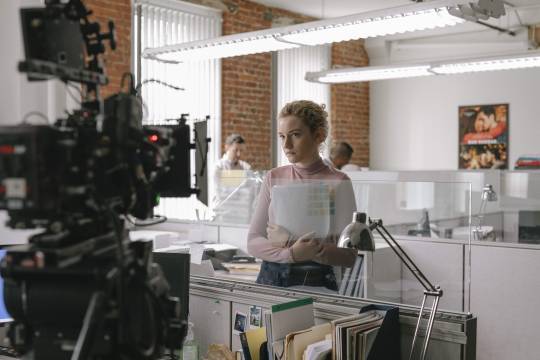
Julia Garner prepares for a take on the set of ‘The Assistant’. / Photo: Ty Johnson
What is your favorite one-woman-show performance, where one female actor entirely carries the film?
A big influence on The Assistant was Chantal Akerman’s Jeanne Dielman, 23 Quai du Commerce, 1080 Bruxelles. It’s just one woman going about her housework. I remember seeing that in film school and being bowled over by it, I’d never seen anything like it.
Do you have a favorite scene that has ever taken place in an office environment?
Offices… I mean, I love The Office? I watched it in preparation for this, even though there’s seemingly nothing in common except for the ways of the photocopier…
It’s important to inhale that kind of comedy while working on something more intense, right?
For sure, that helps.
What is your favorite on-screen argument?
I watched a lot of them to prepare for the HR scene, as it’s a confrontation between two characters. There’s a scene in Steve McQueen’s Hunger, which is a seventeen-minute dialogue. It’s an incredible scene. It’s not an argument but still some sort of confrontation. I was interested in scenes like that which are really long and stand out from the rest of the movie. James Schamus, one of my producers, made a film called Indignation, which has a confrontation between two characters, which also influenced the structure of what I was doing. I also just watched the latest episode of Better Call Saul in which there’s a sixteen-minute confrontation, which I thought was pretty remarkable.
What was the first film that made you want to be a filmmaker?
To be honest I’m not sure. I got a video camera when I was eleven, and I started playing with it in our backyard, making little movies. It wasn’t that I saw a film and tried to replicate it necessarily. But I do have a strange story…
I had a copy of The Sound of Music in which my father had edited out the Nazis, because he was worried I’d be scared of them as a kid. So I have this strange 40-minute version of the film that ends at the wedding scene… And I always thought that was The Sound of Music, and then in high school I figured out there’s this whole other storyline I never knew existed. I guess that taught me the power of editing! I had to go back and rewatch what I’d seen, and it definitely made me think of the craft more as a viewer.
‘The Assistant’ is available to watch on VOD platforms (including Hulu) as of late July.
#kitty green#the assistant#directed by women#female director#independent film#telluride film festival#virtual screening#virtual release#metoo#payuphollywood#hollywood assistant#timesup#juliagarner#matthewmacfadyen#patrickwilson#succession#bettercallsaul#chantel akerman#letterboxd
10 notes
·
View notes
Text
The Best (and Worst) Films of 2019

In many ways, 2019 served as a crucible, and no more so, at least cinematically, than with the venerable superhero flick. After a deluge of big studio films on the subject of capes and spandex (the MCU includes 22 films since the 2008 release of Iron Man; the nascent DCU, running it fits and starts has seven), we saw the explosive close-out of the previous “phases” with Marvel’s Avengers: Endgame; as well as the rise of pseudo art-house comic book film, Joker, in the same bloody year.
The talk on Film Twitter — the living definition of ‘tempest in a teacup’ — was all about those films, and Martin Scorsese’s now legendary take down of the genre by referring to the super hero films, collectively, as “theme parks.” But in truth, there were many, many other films that came out during the year, some of them utterly brilliant, some of them ridiculously awful. Here are my picks for both, with some of what I wrote about them at the time in my review.
10. Avengers: Endgame
“There are so many small but noteworthy details -- opening the film with Traffic's "Dear Mr. Fantasy"; the name drops, and special shout-outs to comics' fans; the small character beats that allow each protagonist more than just a quip or two; the closing credits, which give singular notice to the stars who have been there from the beginning, and wisely do not use the signature Marvel trick of teasing out the next film, which gives the series, at last, a sense of real closure, if only temporary -- the film feels as if it has been created and calibrated with the utmost care. For a film destined to break the bank no matter how shoddy they might have made it, Marvel has poured enough genuine soul into it to earn its inevitable bounty.”
Full Review
9. Her Smell
“In some ways, the film takes on a sort of Raging Bull aspect, Martin Scorsese's classic film about a boxer's rise and fall, only to turn the ending on its head. In Scorsese's picture, we see Jake LaMotta, now fat and retired, attempt to break into showbiz as a comedian, the scenes draped in cutting sardonicism. Perry gives Becky a much less punishingly ironic turn, but instead a hero's journey, venturing away from the abyss into something a good deal less grandiose and realized.”
Full Review
8. The Last Black Man in San Francisco
“It's also a film about the versions of the stories whose ideas lend depth and valor to our otherwise nondescript lives, the things we hope make us the heroes of our own narratives. In this way, Jimmie's story is conflated with that of the city itself, and the palpable sense of loss he feels about his family's house is mirrored in the city's own loss of identity.”
Full Review
7. Under the Silver Lake
“Mitchell fairly stuffs the film with portents, symbols, and runes, some real, some imagined. Squirrels mysteriously fall dead at Sam's feet, a parrot in his courtyard keeps calling out something he can't decipher, a dog killer stalks the neighborhood, and graffiti strewn about the area calls out to him. Films are always encoded with symbolic meaning, utilizing visual language to instill emotion and establish significance for the audience (think of Spielberg's girl with the red coat in Schindler's List, or James Dean's red windbreaker in Rebel Without a Cause), Mitchell's film gives us so many options, almost everything can be read symbolically, which perfectly captures the paranoia his character feels, and the pointlessness of trying to make sense of it at all.”
Full Review
6. Marriage Story
“Noah Baumbach’s latest film, about the dissolution of married couple – played extraordinarily well by Adam Driver and Scarlett Johansson – will no doubt get comparisons made to Bergman’s brilliant Scenes From a Marriage. But whereas that 1972 film concerned the relationship itself, its highs and lows and metamorphoses, Baumbach’s film is much more about the logistics, legal and otherwise, of ending a very much shared life together.”
Capsule Review
5. Midsommar
“Viewing Aster's films is a bit like walking into an art installation -- quite literally, as he populates his frame with stunning compositions and art-focused mise en scene, as with the beautifully designed wooden structures of the compound, or the exquisite murals and art displayed on the building's walls (a huge shout-out to his production designer, Henrik Svensson, and the art directing crew) -- but, as with Hereditary, behind all the sumptuous, hand-crafted beauty, there is a cruel, brutal core of humanity's continued savagery. If art represents the best sort of impulses of humankind, in Aster's hands, it becomes yet another facade, hiding -- or in this case, exemplifying -- our instinct for vicious barbarity.”
Full Review
4. Parasite
“By the end, as it swerves inexorably into blood-soaked violence, the film reveals to be a bit of a con itself, drawing us in with its enticing humor, then opening up into a much darker vision, before ending on an emotional note of surprising vulnerability. Through it all, Bong shows a mastery of odd tones, from the opening comedic salvo, to the final emotional beats.”
Capsule Review
3. Uncut Gems
“It’s one of those pressure-cooker films, where the steam builds more and more intense as Howard gets in and out of trouble through his ability to constantly shift the playing board. There’s a scene about midway through, with various aggrieved characters coalescing at once in his office, as he’s trying to have a speaker phone conversation with his doctor, that’s so stressful, you will want to avert your eyes and remind yourself of the exit signs.”
Capsule Review
2. Once Upon a Time in Hollywood
“It's also an unexpected joy to watch the nonchalant swagger of Pitt match up with DiCaprio's more high-strung ministrations. Two of the biggest film stars alive playing mostly washed up TV actors may stack the irony, but both of them settle in so well into their characters, you can't help but admire the result. Rick is a dude whose ego has gone from tumescent to shriveled -- he parks his car miserably in front of one of his own old movie posters -- but beneath all his hubris and despair, he actually has a lot of talent. As always, it's pure joy to watch Pitt smoke up a screen, a middle-aged Redford speaking every line with a sinfully breezy smile, whose confidence extends around him like the golden hue of his deep suntan.”
Full Review
1. Knives Out
“More than the plot itself, an ingenious and kinetic thing that's as satisfying as a hot bowl of soup on a raw and windy day, there's the sense of joyous chaos from the cast. Those scenes where the family is all together, in the drawing room and continually at each other's throats are so delicious, they should come with a napkin. The interplay between vets like Shannon, Johnson, Curtis and Collette is filled with fractious energy, the characters revisiting age-old disagreements ("Your kid's a brat!" -- "Your kid is a Nazi!") with sadistic glee. Even when they band together, in moments, against what they believe to be a common enemy, it's clear the harmony between them is more Iggy and the Stooges than Beach Boys. In short, Johnson has devised a perfect ensemble of dreadful characters and set them all against one another in a narrative fishbowl filled with lye.”
Full Review
Other Worthy Mentions:
Amazing Grace, American Factory, Apollo 11, Bacurau, Birds of Passage, Charlie Says, Cold Case Hammarskjöld, Dark Suns, Dark Waters, Ford v Ferrari, Greener Grass, In Fabric, John Wick 3, Jojo Rabbit, Luce, Midnight Traveler, Ms. Purple, Pain and Glory, Rewind, Something Else, Terminator: Dark Fate, The Farewell, The Hole in the Ground, The Irishman, The Lighthouse, The Nightingale, The Report, The Souvenir, The Vast of Night, This is Not Berlin, Us, Varda by Agnes, Vitalina Varella
Best Upcoming Releases of 2019
The Personal History of David Copperfield
The Burnt Orange Heresy
Bad Education
First Cow
The Worst Films of 2019
5. Greta
“In short, Jordan turns Greta into a Michael Myers-esque boogeyman, everywhere and no place at once, almost a phantom, but for her high heels and French condemnation. In this way, the filmmaker loses his grip on his material.”
Full Review
4. Ma
“Apart from a truly absurd script, director Tate Taylor's film performs ungainly political gyrations -- asking us to root against a survivor of sexual abuse and humiliation for trying to gain (albeit misplaced) revenge on her attacker. Sort of a rape-revenge thriller set upside down, such that nothing makes any ethical (or emotional) sense. It quickly becomes an awkward mishmash of impulses, wanting to provide cheap scares while fostering a deeply schizoid sense of sympathy, while managing to fail mightily at both.”
Full Review
3. The Dead Don’t Die
“Jarmusch's proclivities have always leaned toward such lightly affecting material -- as if the act of actually generating emotion is somehow vulgar and unseemly -- which has also endeared him to his faction of fans. For everyone else, though, it doesn't leave much to look at. Filmed without fanfare (albeit with a few more special effects than usual, and a kind of cool splattering of sand-like mist when the zombies are beheaded), and with the intensity knobs all turned down to their lowest setting, he continues his sous vide-style of filmmaking. Whether you like the dish he's serving, or want to throw your hands in the air and go somewhere else for dinner is all in your temperament. Whatever you choose, you can be certain the same menu will be available the next time you venture back.”
Full Review
2. Dark Phoenix
“The clearest loss, however, is with the story itself -- its legacy struck deep in Marvel lore -- once again being studio nitpicked, and focus-grouped to within an inch of its life. If Endgame audaciously proved a superhero movie could rise toward an emotionally satisfying arc, this failed attempt proves the opposite is also true: Chronic incoherence, even if spread out among a multitude of titles over 20 years, just feels like a soulless money grab. Adding to the sense of this film's slapdashery, the trailer features lines and moments unused in the actual cut, which is never a good sign.”
Full Review
1. Lucy in the Sky
“The film is meandering and pretty much pointless, a major flaw that Hawley himself indicated in his introduction (“we work as hard on the bad ones as we do the good ones,” he told the audience in an example of supreme foreshadowing. Portman does her best, but the film sputters pretty hard, and is never able to justify itself.”
Capsule Review
Other Dishonorable Entries:
The Aftermath, The Curse of La Llorona, Gemini Man, Glass, Hellboy, Joker
Inexplicably Overrated: Joker, The Dead Don’t Die
Biggest Welcome Surprise(s): Ford v Ferrari, Once Upon a Time in Hollywood
Most Bitter Disappointment(s): The Lodge, Wounds
Film That Critics Got Wrong: Waves
Best Film I Saw Last Year, Period: Scenes From a Marriage
#sweet smell of success#ssos#piers marchant#films#movies#the best and worst films of 2019#knives out#parasite#once upon a time in hollywood#uncut gems#marriage story#the last black man in san francisco#midsommar#avengers: endgame#under the sliver lake#her smell
5 notes
·
View notes
Text
Teaching Artist Institute: “Children at the Center”
Tuesday, August 27th to Wednesday, August 28th at the National Building Museum, the DC Commission on the Arts and Humanities hosted a Teaching Artist Institute with co-hosts from the National Building Museum along with the DC Arts and Humanities Education Collaborative. There were 59 DC-based teaching artists who participated in a variety of sessions and workshops that were facilitated by 31 moderators, panelists, and staff volunteers. The “Children at the Center” Teaching Artist Institute focused on providing the opportunity for teaching artists to build skills and understanding in their field of teaching artistry.
TAI Resources:
Informational Flyer
Session Descriptions
Schedules at a glance
Day One
Day Two
Personal Bio Descriptions of Facilitators, Moderators, and Panelists
Tuesday, August 27th Agenda
1:30pm - Registration & Welcome
2:15pm - Keynote Panel: Children at the Center
3:30pm - Coffee Break
4:00pm - Workshop Breakout Sessions
5:30pm - Break - Journey to Shakespeare Theatre Company
6:00pm - Teaching Artist and Practitioner Speed Dating Networking Reception: Importance of Collective Impact, Hosted by DC Collaborative’s Any Given Child DC program and Shakespeare Theatre Company
Wednesday, August 28th Agenda
9:30am - Breakfast
10:00am - Keynote Panel: Program Design
11:15am - Morning Workshop Breakout Sessions
12:45pm - Lunch - Pecha Kucha Presentations
2:00pm - Afternoon Workshop Breakout Sessions
3:45pm - Keynote Panel: Assessment & Evaluation
4:45pm - Closure
Highlights: Tuesday, August 27th

Keynote Panel: Children at the Center
The TAI began with a Keynote Panel. The panel was titled “Children at the Center: Addressing the Full Humanity of Each Student.” Panelists shared how they addressed the needs of the individual students they serve and how they broadly shape their programming around the unique needs of the communities in which they work. The Panel was moderated by Erika Hawthorne from Arts Education Partnership/Education Commission of the States featuring panelists Mary Brown (Life Pieces to Masterpieces), Kahina Haynes (Dance Institute of Washington), Tara Libert (Free Minds Book Club & Writing Workshop), and Christie Walser (Project Create).
Workshop A
Workshop A was facilitated by Jessica Valoris. Valoris is a DC-based multi-disciplinary artist who is a proud alum and Assistant Director of The Atlas Performing Arts Center’s City at Peace DC. The workshop was titled “Finding My Center: Devising Wellness in Community” and was targeted for teaching artists of teens and adults. This workshop focused on exploring holistic wellness practices that educators, artists, and young people can share to support one another.
Workshop B
Workshop B was facilitated by Lauren Wilson. Wilson oversees the Community Engagement team at the National Building Museum, which includes programming for teen and intergenerational audiences. Wilson’s workshop was titled “Co-Creating and Collaborating with Teens” which was directly targeted for teaching artists of teenagers. This workshop discussed strategies for sharing leadership and creativity with teens tailored to each participant’s individual work and practice.
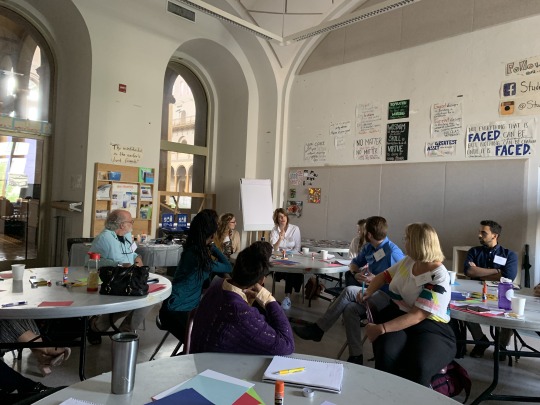
Workshop C
Workshop C was facilitated by Lindsey Vance. Vance is an artist, art therapist, licensed professional counselor, and educator. Vance’s workshop was titled “The Joy of Making Art: Intuitive Collage & Meaning Making” and was suitable for teaching artists of all ages. This session provided an understanding of the therapeutic power of visual arts through intuitive intelligence, experimentation, and narrative.
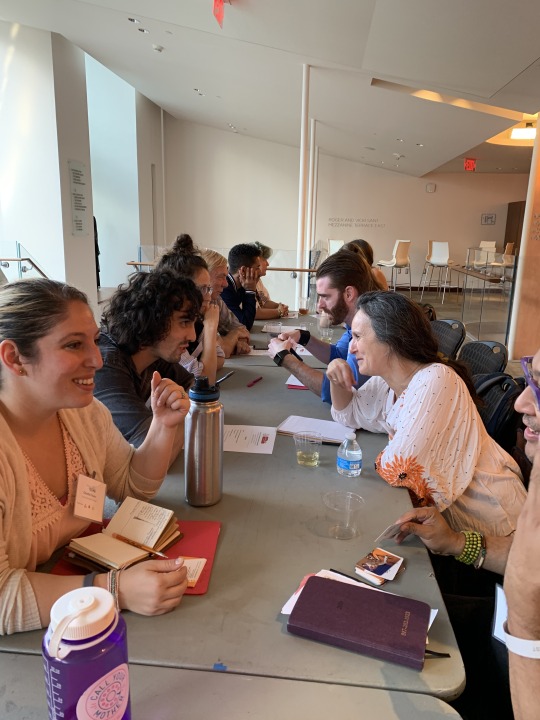
Collective Impact: Speed Dating
The DC Collaborative and Any Given Child DC held a Collective Impact Speed Dating workshop for teaching artists! Participants listened to why they should be involved in the Collective Impact Any Given Child DC work and interacted with their peer practitioners. Thank you to our host, Shakespeare Theatre Company!
Highlights: Wednesday, August 28th
Keynote Panel: Program Design
Wednesday morning began with a Program Design panel titled “Positioning Everyone for Success.” The panel was moderated by David Markey who currently oversees arts education programming for the DC Commission on the Arts and Humanities. Panelists included Kristen Anclien (Bridges PCS), Michelle Edwards (Live It Learn It), Peter Guttmacher (Consultant), and Mary Lambert (DCPS). This panel discussed important considerations to keep in mind in the design of in-school and out-of-school-time residencies.
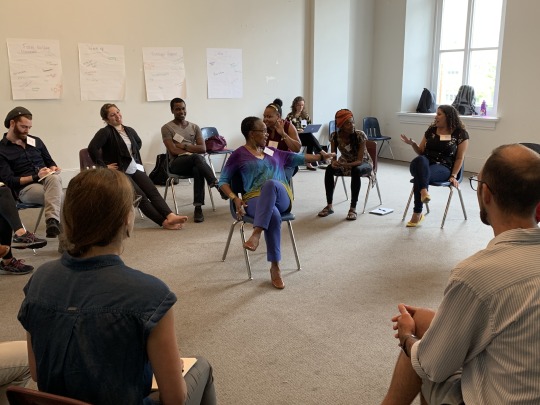
Workshop D
Workshop D was facilitated by Nikki Kaplan. Kaplan is the Associate Director of Education at Imagination Stage. Kaplan’s workshop was titled “Game Exchange! Tools of the Trade” and was suitable for teaching artists of all ages. In this workshop, participants exchanged classroom games, exercises, warm-ups, and technique/skill-building activities to add to their tool-kits.
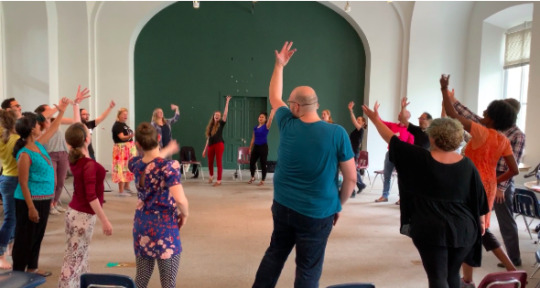
Workshop E
Workshop E was facilitated by nationally recognized master teaching artist Margot Greenlee. Greenlee’s workshop was titled “Dance and Theater Practice for Children of All Ages and Abilities” and was suitable for teaching artists of all ages. Participants learned collaborative methods that invite each child’s contribution, with special attention to supporting children with intellectual and developmental disabilities.
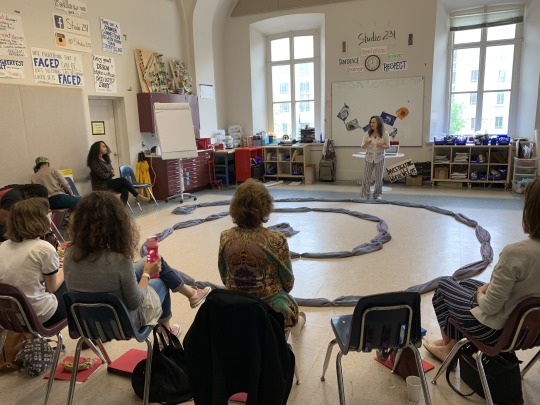
Workshop F
Workshop F was facilitated by teaching artists Sylvia Zwi and Marcia Daft. Zwi holds the position of Dean and Director of Early Childhood Arts & Professional Development at Sitar Arts Center. Daft is the founder of Moving Through Math and Teaching the Music of Language. This workshop was titled “Spiral Up (It’s in the “How”)” and was targeted at teaching artists of early-elementary but was applicable to all ages. Participants were introduced to seeds of movement and music ideas to provoke a student-generated response in semi-improvisational processes.
Workshop G
Workshop G was facilitated by teaching artist Imani Gonzalez. Gonzalez’s workshop was titled “Telling Your Story through the Blues” and was targeted for teaching artists of Grades 4-8. Participants explored the strategies that are aligned with Writer’s Workshop to engage in the composition blues songs that express thoughts, feelings, experiences, and then performed them.

Workshop H
Workshop H was facilitated by Regie Cabico. Cabico is a poet and a spoken word pioneer having been the first openly queer and Asian American writer to win the Nuyorican Poets Cafe Grand Slam. Cabico’s workshop was titled “I’M BRAVE AS A MIGHTY OCEAN: INTRODUCTION TO SPOKEN WORD SLAM POETRY” and was designed for teaching artists of 6th grade and up, but could be modified for elementary school. Participants examined strategies to help students write through imagery and break down the components of slam poetry by demystifying the elements of a great slam poem through writing that addresses poetic devices.
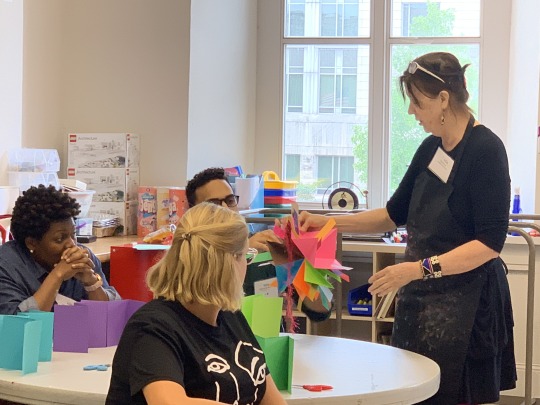
Workshop I
Workshop I was facilitated by professional teaching artist Karen O. Brown. Brown’s workshop was titled “Tricks Up Your Sleeve - for Every Teaching Artist” and was targeted for teachers of Pre-K 3 to High School. Teaching artists learned simple and effective techniques and processes to use with students. This included making handmade book structures (pictured above) and ways to use a variety of artistic expression to share strategies.
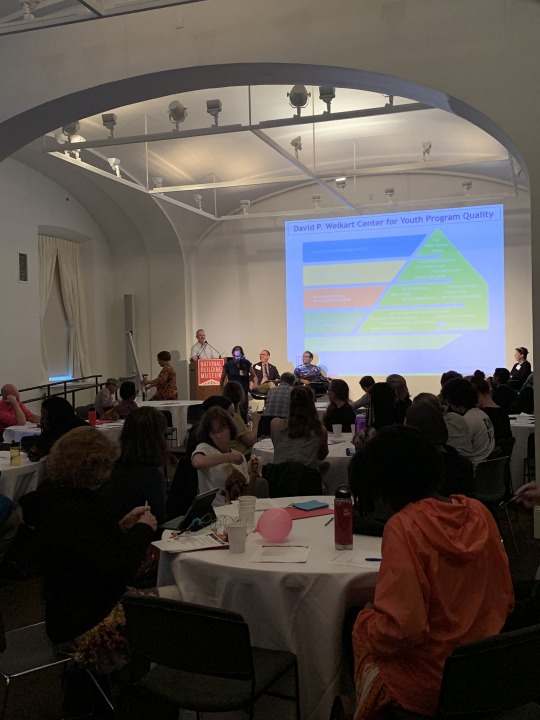
Keynote Panel: Assessment and Evaluation
The Teaching Artist Institute closed with a final Keynote Panel discussing Assessment and Evaluation titled “What is Quality? Really?”. This panel was moderated by Kevin Cataldo who is the Manager of the Institute for Youth Development part of the Office of Out of School Time Grants and Youth Outcomes as well as Office of the Deputy Mayor for Education. Panelists included Karen Brown, Regie Cabico, and Imani Gonzalez. This panel discussed the role that teaching artists play in the process of evaluating the quality and impact of programming and how can assessment be used for good.
Gratitude
At the Teaching Artist Institute: Children at the Center, attendees were not only able to gain experience and methods to bring back to their classroom but also learned strategies to better themselves as teaching artists. At this two-day event, the wide range of workshops, panels, facilitators, moderators, and panelists provided a variety of artistic fields for teaching artists to explore.
The DC Arts and Humanities Education Collaborative would like to thank the DC Commission on the Arts and Humanities, the National Building Museum, Shakespeare Theatre Company, and all of our facilitators, moderators, panelists, and volunteers for making this Teaching Artist Institute as successful as it was. We hope to continue to host more institutes for teaching artists in the future!
#CollaborativeEffect#ArtsEd#HumanitiesEd#DCArts#TeachingArtistInstitute#ProfessionalDevelopment#general news
1 note
·
View note
Link
The Assassination of Gianni Versace was a big departure from the first season of American Crime Story in many ways. First of all, it is told in reverse. It opens with the titular murder of the fashion designer, and goes backwards into the other three murders that Andrew Cunanan committed, and traces back his childhood and upbringing. The show is less a legal procedural like O.J. and more a psychological dive into the mind of a broken man, and the emotional ramifications of his actions. The two seasons have completely different visual and narrative styles. They are written by different people. They are linked only by the series title after the colon.
Writer Tim Robb Smith uses Andrew’s story to make a larger comment about, among many other things, fame, self-hatred and the trauma of the closet...
He uses a backwards structure to deconstruct myths and humanize monsters. Just as the series looks and feels different than its previous iteration (more poetic, less plot-driven), the script does as well. As I’ve discussed previously in this column, action lines and descriptions in a script are a chance for writers to really tap into their inner novelist. Smith really takes that chance to further explore the themes of the show.
The Assassination of Gianni Versace: American Crime Story
“House by the Lake”
Season 2, Episode 4
Written by: Tim Robb Smith
[You can read the entire script here.]
Previously in this Emmy wave of Blueprints installments we've looked at pilots but a pilot does not a series make. The most striking moments of a series tend to happen further on (and should; otherwise the show is not doing so well).
“House by the Lake”, the fourth episode of the season, focuses on Andrew and architect David Madson, the object of his unfaltering love, and later on, his rage. Through the episode, Andrew forces David to go on a cross country road trip with him, which culminates tragically in, well, a house by a lake. We get a deeper background on David himself, and his own upbringing in a rural environment, and his struggles growing up gay.
The final moments of the episode detail the final moments in David’s life. Andrew has found out his attempts to escape, and shoots him. The last three pages of the script are nothing but descriptions. No dialogue. Just wordless imagery unfolding through character moments, memories, and blocking. Sentences that reveal emotions:
“David has seen that look before, when Andrew attacked Jeff -- so he knows.”
“We’re desperately hoping he’ll get away..."

As Davis runs away from Andrew and tries to avoid his shot, he runs into a shed. As he goes inside, he is not on the run anymore. He is by another house by another lake. “This is now the simple hunting shack from his childhood. We’ve switched locations in David’s mind, merging the two.” His dad is there, and hands him a beverage. David takes it; he’s welcomed and accepted.
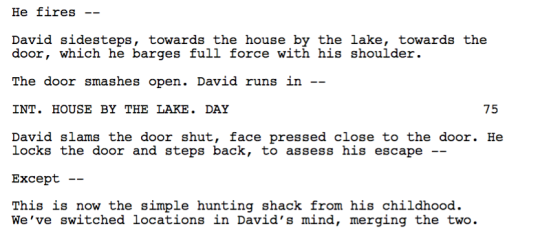
***

***
But he is not really there. That’s not how it ends for him. “In reality, the bullet impacted in David’s back, between the shoulder blades, and he’s in process of tumbling to the ground, face first.” He lands on the grass. He looks up at the clouds (“the beautiful clouds”). He remembers his carefree childhood, when he would run in a similar field. It’s the closure of tragic emotional circle for David.

The episode does not end with David, but Andrew’s delusional perception of what he just did. “He sits beside the body of David, staring at the water. He puts the gun down in the grass. He lays beside David’s body and rests an arm around him, as though they were a couple, sleeping together.” He falls asleep. He wakes up. He stands up and leaves David’s body behind. Just like that. He leaves behind a baggage that, as we have seen in previous episodes, will slowly catch up with him.
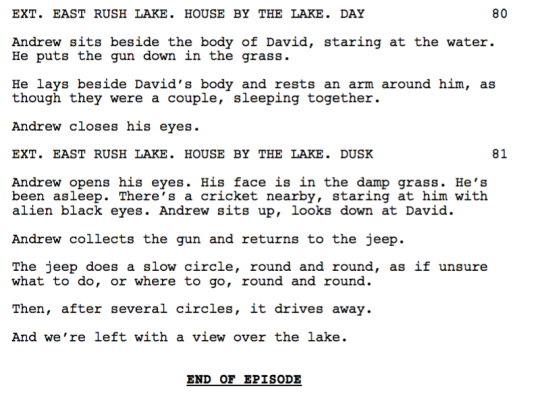
David is forgotten in the house by the lake. But his memory prevails through the remaining episodes. The show makes a point by not making him just another statistic in a serial victim’s bio. He’s part of a larger narrative. He’s part of larger story. and that’s what The Assassination of Gianni Versace is about, after all. Not about the murder of one man, or about the man that committed it. It’s about everything around it. It’s about the culture that allowed it to happen. It’s not the character dialogue, but the unsaid action lines and descriptions.
6 notes
·
View notes
Text
Essay 1: Prisoners of the Human Condition
The ghost of Zona Heaster Shue reveals not only the problematic gender roles that have existed since before the late 1800’s, but also how we are not just a people of reason, but faith as well, and lastly, leads us to the haunted history of prisons in America. Zona’s husband was merely ignored by most, even while displaying erratic, controlling, and possessive behavior. We see the role of toxic masculinity play out in this story through her husband, and instead of focusing on it as a potential factor in the cause of Zona’s death, it is shrugged off as a man’s way of dealing with the death of his wife, despite his questionable past. Instead of raising boys to be emotionally aware and vulnerable, we teach them strength, pride, ownership, and aggression. Zona’s mother attempts to take the situation into her own hands after being haunted by the ghost of her daughter. It is because of this paranormal and spiritual experience that Trout, Zona’s husband, was sentenced to life imprisonment for the murder of his wife. This reveals how faith and the fascination with the unknown is intertwined into our human condition, through religion, ghost sightings, spiritual experiences, metaphysical intuitions, and convicting a man of murder based off a haunting. Although the haunting did produce some physical truth giving it much more credibility. The seemingly unexplainable physical evidence that came out of the haunting is what made it tangible, believable, and ultimately the reason why Trout was sentenced to life in prison. The potential reason why he was not instead given the death penalty, which was common at the time, could be due to the underlying apprehension towards the fact that this was the outcome of a seemingly inexplainable paranormal experience.
After this story, Colin Dickey of Ghostland: An American History in Haunted Places, then puts us inside the American Prison System. The same prison Trout lived and died in became known for its horrific treatment of inmates, leading to the prisons closure, the doors to the spiritual realm to be opened, and dark tourism to take over.
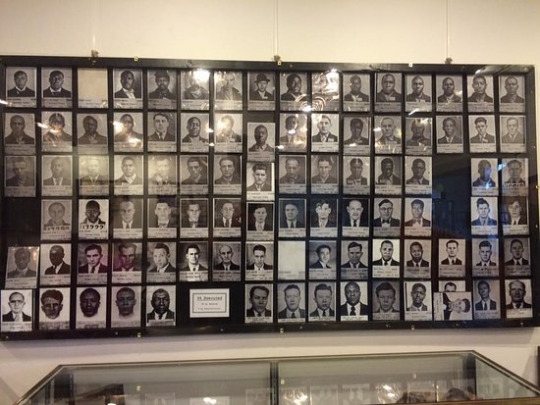
( Image: West Virginia Penitentiary: Faces of the executed prisoners during the life of the prison.)
Prisons are interesting places. This idea that crime takes away from our humanness and therefor you must be exiled from society to pay for your crimes is one that deserves further analysis. It is an institution put in place to hide the darkness that can reside in the human form. The further we separate criminals to the human form, the easier it is for us to suppress and separate ourselves from the darker sides of existence and the human condition. Dickey allows us to see it from the perspective of sociologist Margee Kerr, “In the public act of confining the criminal, or the ‘abnormal’ other, societies reaffirm their shared values, the difference between ‘us’ and ‘them’ become visible, and the dividing lines are fortified” (163) So many of the systems we have in place in our society reinforce this idea of segregation. Separating us by any means possible, race, gender, class, able-bodiedness, good vs bad. It is based out of our need for survival, and criminals threaten our safety, and therefor means of survival, and thus must be exiled. Yet, the dark tourism that takes place in some of these abandoned prisons allows us to step into the mind and life of the imprisoned criminal, just long enough to get a glimpse of how they lived, breathed, and thought, but not long enough to feel the full weight, to get sucked in, and to face the darker sides that we suppress by historically pushing those thoughts and feelings to the side because they no longer make you an acceptable and respectable member of society. Kerr reveals “you are also relieved by the recognition at the tours end, that you are not one of the ‘bad guys’” (163). At the end of the tour, they get to walk away, reminding them of their role in society and how the only time they would ever want to end up at places such as these is by personal choice; as a visitor, not a resident.

Dickey suggests that we should feel unsettled, and disturbed by these tours, by these places, by parts of our history, not feeling better about ourselves because we weren’t there, we weren’t them, or we weren’t involved. But being a human makes you involved. These stories and places are deeply encoded into our history, and therefor, our collective consciousness. The Stanford prison experiment is a perfect example, of how even people who are supposedly “normal” when immersed in such environments, are driven to do the same thing they were expected never to do. How under the right conditions, our suppressed selves will find a way to escape. It allowed us to see the flaws in the system, not just the people. This is the history and dark realities of the world we live in, injustice that has not disappeared along with bodies, ghosts being a haunted reminder of this. This is something real and frightening that took place in our society. When we tell it through the perspective of a ghost story, versus a historical narrative, it lessens the severity. Some view ghosts as myths and fantasy and allow them not to fully feel the weight behind the history. Ghost tours are a temporary sensation, a drug for the tourists. It is a way to get your fix without having to stay long enough to let the full weight of the reality sink in. A distraction from truth. To remain a spectator and not a inhabitant.
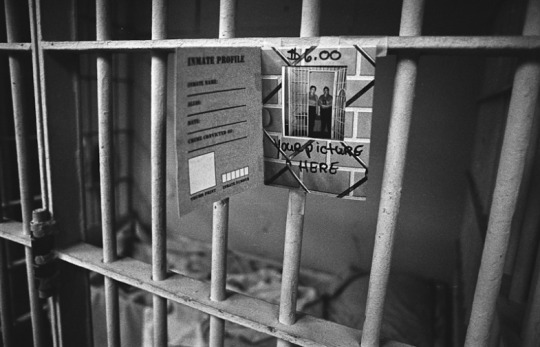
The systems we have created in this country have become just that in many ways, a distraction from truth. The prison system, down to its architecture, has been crafted to let the people on the inside know that they are not in a beautiful place, that they are not supposed to be comfortable, that they are not supposed to want to be there, and it lets the people on the outside know this too. It is a secluded place keeping you trapped on the inside from experiencing the outside world, and keeping outsiders blind, apathetic to, and deterred from what is happening on the inside. Everything we can process with our senses evokes an emotional response and prisons take advantage of that. With their monotonous and dreary colors, the windowless hallways, cold prison bars, spiked fences, etc.. All there to remind you that you are trapped, desensitized, de-humanized and removed of privilege and agency. We put everyone in the same uniform and give them numbers, taking away from their humanness and adding to their imposed insignificance and confinement.
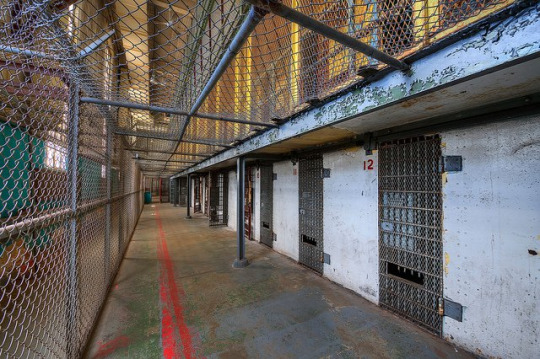
Despite studies that reveal practices such as solitary confinement are more psychologically damaging then helpful in aiding inmates to realize what they have done is wrong, we still impose practices such as these. We want criminals to pay and suffer for what they did because they are not like us, and are less deserving of love, compassion, and understanding. We run prisons to punish, not to rehabilitate; because instead of putting in the extra work to treat inmates as humans with the potential ability to heal, we would rather make them disappear and keep them far away from our society over fear of safety and survival, while profiting off of the ghosts of their bodies. It is much easier to confront the ghost of them then the actual human. It is easier for us to live through supposed fantasy as opposed to face reality.
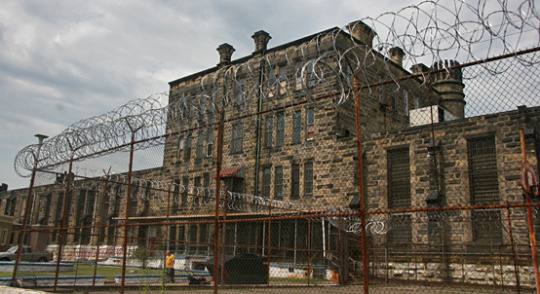
2 notes
·
View notes
Text
The Complicated Impact of Covid-19 on the Craft Beer Industry
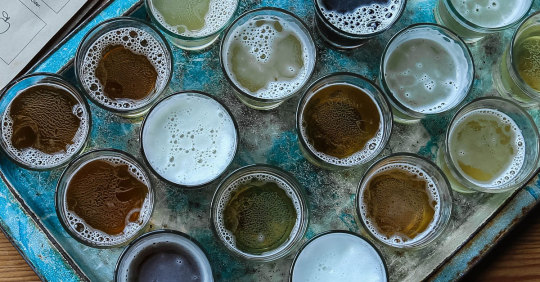
Six months into the pandemic and two narratives continue to lead conversations surrounding alcohol sales in the U.S. The first, by all accounts, is that off-premise alcohol sales are up. Most reports suggest that larger brands are mainly benefitting from this trend while craft producers have not seen the same boost.
There’s a significant number of testimonies from market analysts supporting these narratives. But the more we scrutinize the numbers, the more it becomes apparent this is a nuanced conversation — one that’s impossible to sum up with a one-size-fits-all answer. Nowhere is this more true than in craft beer.
While craft beer has seen upticks at retail, those gains have not offset the losses from bar and restaurant closures across the industry. However, to say that the entire craft beer industry is reeling from on-premise closures is also an oversimplification. There are profits being made in beer right now, and not all of those are being banked by macro producers.
To find out exactly how Covid-19 has impacted the craft beer industry, VinePair spoke with industry analysts, producers around the country, and professionals working in sectors that support craft beer. They highlighted the factors that have hit brewers hardest during the pandemic and the business models that have been most impacted, as well as predicting what the pandemic could mean for the future of craft beer.
The Impact of On-Premise Sales Losses
While off-premise sales data seems to paint a positive picture for craft beer versus beer as a whole, industry analysts say these figures don’t tell the whole story. For the 26-week period that ended Sept. 5, beer sales rose 11.2 percent in value, while craft beer sales increased 16.3 percent, according to Nielsen data. But these increases have not canceled out the widespread losses from sales at bars and restaurants.
Prior to the pandemic, many craft brewers placed more emphasis on on-premise sales, because that channel offers greater profit margins. Bart Watson, chief economist at the Brewers Association, estimates that on-premise sales accounted for 45 percent of craft beer volume sales before Covid-19.
With lengthy on-premise closures and continued capacity restrictions, the loss (or significant reduction) of this vital revenue stream has had a notable impact. “The craft beer category is estimated to be down around 12 to 15 percent in the first half of 2020 versus the same period in 2019,” says Adam Rogers, North American research director for IWSR.
The Challenges of Pivoting to Off-Premise Sales
In order to combat on-premise losses, many brewers have turned to packaging their beer in cans and bottles, and selling to wholesalers or direct to consumers via curbside pickups. While this has presented a vital lifeline during the pandemic, packaging and indeed selling that beer has not come without its challenges.
“Even if you can bottle or can beer, you have to sell it to somebody,” the Brewers Association’s Watson says. Gaining retail placements had become increasingly hard even before the pandemic, he says, and proved to be tougher still within the more competitive Covid landscape. For those brewers who could get their beers on grocery store shelves, that still didn’t guarantee sales — especially during the early stages of the pandemic.
During the “pantry loading” months of March, April, and June, consumer purchasing habits shifted to favor macro brands and their larger packaging formats (12-packs and cases), according to analysts such as the IWSR. Brewers contacted for this piece confirmed this theory and further explained why larger packaging is not a feasible option for smaller producers.
“The problem for us as craft brewers is we’re not as poised as the larger brewers to meet that kind of demand,” says Sam Cruz, co-founder of Against The Grain Brewery in Louisville, Ky. “Another caveat of that is the price factor: Shoppers are looking for value in those larger formats; if we meet that value point, we’re going to lose margins.”
The success of pivoting to canning has also been largely dependent on a brewery’s location, according to Roger Kissling, VP of sales and customer management at Iron Heart Canning Co. Iron Heart operates in 25 states and Kissling confirms demand for his company’s services has increased during the pandemic. But not across the board. Breweries in large urban areas have found success from mobile canning because they’ve been able to take advantage of to-go sales and curbside pickup, Kissling explains. But this has not been the case in more sparsely populated rural markets.
Further complicating matters has been a high-profile aluminum can shortage. This issue existed before the pandemic, but Covid has only exacerbated the growing demand for aluminum cans, explains Jon Beam, marketing manager at can manufacturer Crown Beverage Packaging. With increased at-home consumption of beer and other canned beverages, the pandemic has driven demand for aluminum cans to an “all-time high,” he says, creating “an unexpected surge” the industry is still working to address. Crown Beverage is among a number of packaging manufacturers now working on plant expansions and line additions to meet the continued demand for aluminum cans.
Self-Distribution Proves to Be a Lifeline
By all accounts, having solid relationships with distributors has been a key factor to surviving the pandemic for craft producers. Another approach that has proven particularly successful during this period has been the flexibility and control offered by self-distribution, as illustrated by the Massachusetts-based Night Shift Brewing and New York’s Other Half Brewing.
Michael Oxton, co-founder of Night Shift Brewing, predicts revenues for his business will be up this year, though overall profits will likely be down compared to 2019. Night Shift has an annual output of around 40,000 barrels, most of which is sold through wholesale channels. Night Shift also operates a separate distribution business, so it has not faced the challenge of creating new distributor relationships nor struggled to gain retail shelf space. “We will likely be down profit-wise just because our taprooms are so profitable and we are seeing a huge downturn in revenues there,” Oxton says.
Other Half Brewing is another example of a brewery that almost entirely self-distributes, though in a different model from Night Shift. Prior to the pandemic, up to 40 percent of Other Half’s production went into kegs, while the remaining 60 percent was packaged in cans and mainly sold at its breweries. “We have stopped packaging beer in draft format altogether,” co-founder Matt Monahan says. “Beforehand it was mostly cans to-go. Now, we are all cans to-go minus a couple of key retail partners.”
Confidence In the Craft Beer Market
Craft beer was already becoming an increasingly competitive space prior to the pandemic, with record numbers of producers and competition from hard seltzers and canned cocktails. Judging the exact impact of Covid-19 on the subcategory is therefore tricky. But certain data sets appear to support the notion that confidence in craft beer remains high, even now.
As of June 30, data from the Brewers Association showed there were 8,217 active craft breweries in the U.S., up from 7,480 during a comparable time frame last year. Watson puts this down to the timeframe involved in opening a brewery — it’s a process that can take years, he says.
A better indication of the current confidence in craft beer may be the number of brewery permit applications submitted to the TTB. Somewhat surprisingly, that total has also grown this year, to the tune of 219 new applications between Q2 and Q3. Given that all of these permit applications were submitted during the pandemic, as Watson pointed out in a recent tweet, this could suggest many still believe they can operate new businesses profitably in craft beer. But it should also be noted this was the slowest growth for new permits in 11 quarters, according to Watson.
The Future of the Craft Beer Industry
Sources contacted for this article said they did not think the pandemic would not weaken the long-term demand for craft beer in the U.S. The overall opinion was instead that the pandemic would change the landscape of who’s meeting that demand.
“A portion of the breweries that had to close recently may have had to close in three to five years due to the increased competition, so the pandemic just condensed their timeline,” says IWSR’s Rogers.
Still, market analysts like the IWSR predict the craft beer industry will return to a “healthy” landscape within two years, and volume losses will also be regained in the coming years. But crucial to the continued health of the industry will be a diversification of revenue streams for brewers. While we shouldn’t doubt that the taproom and draft-focused business model will prevail in the future, when it comes to growing a business, increasing production size, and gaining a multi-state footprint, packaged beer and well-established wholesaler relationships will likely be key.
Within retail channels, consumers can not only expect a reduction in brands on shelves, but also a streamlining of styles. “I think this is really going to cull the selection because stores were already overwhelmed with the amount of variety on offer,” says Night Shift’s Oxton.
One pandemic trend all hope will continue is the manner in which consumers have increasingly supported local businesses. “As long as the quality is there, consumers will also be there,“ IWSR’s Rogers says.
The article The Complicated Impact of Covid-19 on the Craft Beer Industry appeared first on VinePair.
source https://vinepair.com/articles/impact-covid-19-craft-beer-industry/
0 notes
Text
The Complicated Impact of Covid-19 on the Craft Beer Industry

Six months into the pandemic and two narratives continue to lead conversations surrounding alcohol sales in the U.S. The first, by all accounts, is that off-premise alcohol sales are up. Most reports suggest that larger brands are mainly benefitting from this trend while craft producers have not seen the same boost.
There’s a significant number of testimonies from market analysts supporting these narratives. But the more we scrutinize the numbers, the more it becomes apparent this is a nuanced conversation — one that’s impossible to sum up with a one-size-fits-all answer. Nowhere is this more true than in craft beer.
While craft beer has seen upticks at retail, those gains have not offset the losses from bar and restaurant closures across the industry. However, to say that the entire craft beer industry is reeling from on-premise closures is also an oversimplification. There are profits being made in beer right now, and not all of those are being banked by macro producers.
To find out exactly how Covid-19 has impacted the craft beer industry, VinePair spoke with industry analysts, producers around the country, and professionals working in sectors that support craft beer. They highlighted the factors that have hit brewers hardest during the pandemic and the business models that have been most impacted, as well as predicting what the pandemic could mean for the future of craft beer.
The Impact of On-Premise Sales Losses
While off-premise sales data seems to paint a positive picture for craft beer versus beer as a whole, industry analysts say these figures don’t tell the whole story. For the 26-week period that ended Sept. 5, beer sales rose 11.2 percent in value, while craft beer sales increased 16.3 percent, according to Nielsen data. But these increases have not canceled out the widespread losses from sales at bars and restaurants.
Prior to the pandemic, many craft brewers placed more emphasis on on-premise sales, because that channel offers greater profit margins. Bart Watson, chief economist at the Brewers Association, estimates that on-premise sales accounted for 45 percent of craft beer volume sales before Covid-19.
With lengthy on-premise closures and continued capacity restrictions, the loss (or significant reduction) of this vital revenue stream has had a notable impact. “The craft beer category is estimated to be down around 12 to 15 percent in the first half of 2020 versus the same period in 2019,” says Adam Rogers, North American research director for IWSR.
The Challenges of Pivoting to Off-Premise Sales
In order to combat on-premise losses, many brewers have turned to packaging their beer in cans and bottles, and selling to wholesalers or direct to consumers via curbside pickups. While this has presented a vital lifeline during the pandemic, packaging and indeed selling that beer has not come without its challenges.
“Even if you can bottle or can beer, you have to sell it to somebody,” the Brewers Association’s Watson says. Gaining retail placements had become increasingly hard even before the pandemic, he says, and proved to be tougher still within the more competitive Covid landscape. For those brewers who could get their beers on grocery store shelves, that still didn’t guarantee sales — especially during the early stages of the pandemic.
During the “pantry loading” months of March, April, and June, consumer purchasing habits shifted to favor macro brands and their larger packaging formats (12-packs and cases), according to analysts such as the IWSR. Brewers contacted for this piece confirmed this theory and further explained why larger packaging is not a feasible option for smaller producers.
“The problem for us as craft brewers is we’re not as poised as the larger brewers to meet that kind of demand,” says Sam Cruz, co-founder of Against The Grain Brewery in Louisville, Ky. “Another caveat of that is the price factor: Shoppers are looking for value in those larger formats; if we meet that value point, we’re going to lose margins.”
The success of pivoting to canning has also been largely dependent on a brewery’s location, according to Roger Kissling, VP of sales and customer management at Iron Heart Canning Co. Iron Heart operates in 25 states and Kissling confirms demand for his company’s services has increased during the pandemic. But not across the board. Breweries in large urban areas have found success from mobile canning because they’ve been able to take advantage of to-go sales and curbside pickup, Kissling explains. But this has not been the case in more sparsely populated rural markets.
Further complicating matters has been a high-profile aluminum can shortage. This issue existed before the pandemic, but Covid has only exacerbated the growing demand for aluminum cans, explains Jon Beam, marketing manager at can manufacturer Crown Beverage Packaging. With increased at-home consumption of beer and other canned beverages, the pandemic has driven demand for aluminum cans to an “all-time high,” he says, creating “an unexpected surge” the industry is still working to address. Crown Beverage is among a number of packaging manufacturers now working on plant expansions and line additions to meet the continued demand for aluminum cans.
Self-Distribution Proves to Be a Lifeline
By all accounts, having solid relationships with distributors has been a key factor to surviving the pandemic for craft producers. Another approach that has proven particularly successful during this period has been the flexibility and control offered by self-distribution, as illustrated by the Massachusetts-based Night Shift Brewing and New York’s Other Half Brewing.
Michael Oxton, co-founder of Night Shift Brewing, predicts revenues for his business will be up this year, though overall profits will likely be down compared to 2019. Night Shift has an annual output of around 40,000 barrels, most of which is sold through wholesale channels. Night Shift also operates a separate distribution business, so it has not faced the challenge of creating new distributor relationships nor struggled to gain retail shelf space. “We will likely be down profit-wise just because our taprooms are so profitable and we are seeing a huge downturn in revenues there,” Oxton says.
Other Half Brewing is another example of a brewery that almost entirely self-distributes, though in a different model from Night Shift. Prior to the pandemic, up to 40 percent of Other Half’s production went into kegs, while the remaining 60 percent was packaged in cans and mainly sold at its breweries. “We have stopped packaging beer in draft format altogether,” co-founder Matt Monahan says. “Beforehand it was mostly cans to-go. Now, we are all cans to-go minus a couple of key retail partners.”
Confidence In the Craft Beer Market
Craft beer was already becoming an increasingly competitive space prior to the pandemic, with record numbers of producers and competition from hard seltzers and canned cocktails. Judging the exact impact of Covid-19 on the subcategory is therefore tricky. But certain data sets appear to support the notion that confidence in craft beer remains high, even now.
As of June 30, data from the Brewers Association showed there were 8,217 active craft breweries in the U.S., up from 7,480 during a comparable time frame last year. Watson puts this down to the timeframe involved in opening a brewery — it’s a process that can take years, he says.
A better indication of the current confidence in craft beer may be the number of brewery permit applications submitted to the TTB. Somewhat surprisingly, that total has also grown this year, to the tune of 219 new applications between Q2 and Q3. Given that all of these permit applications were submitted during the pandemic, as Watson pointed out in a recent tweet, this could suggest many still believe they can operate new businesses profitably in craft beer. But it should also be noted this was the slowest growth for new permits in 11 quarters, according to Watson.
The Future of the Craft Beer Industry
Sources contacted for this article said they did not think the pandemic would not weaken the long-term demand for craft beer in the U.S. The overall opinion was instead that the pandemic would change the landscape of who’s meeting that demand.
“A portion of the breweries that had to close recently may have had to close in three to five years due to the increased competition, so the pandemic just condensed their timeline,” says IWSR’s Rogers.
Still, market analysts like the IWSR predict the craft beer industry will return to a “healthy” landscape within two years, and volume losses will also be regained in the coming years. But crucial to the continued health of the industry will be a diversification of revenue streams for brewers. While we shouldn’t doubt that the taproom and draft-focused business model will prevail in the future, when it comes to growing a business, increasing production size, and gaining a multi-state footprint, packaged beer and well-established wholesaler relationships will likely be key.
Within retail channels, consumers can not only expect a reduction in brands on shelves, but also a streamlining of styles. “I think this is really going to cull the selection because stores were already overwhelmed with the amount of variety on offer,” says Night Shift’s Oxton.
One pandemic trend all hope will continue is the manner in which consumers have increasingly supported local businesses. “As long as the quality is there, consumers will also be there,“ IWSR’s Rogers says.
The article The Complicated Impact of Covid-19 on the Craft Beer Industry appeared first on VinePair.
Via https://vinepair.com/articles/impact-covid-19-craft-beer-industry/
source https://vinology1.weebly.com/blog/the-complicated-impact-of-covid-19-on-the-craft-beer-industry
0 notes
Text
Street Vendors Get the Star Treatment They Deserve in ‘Street Food’
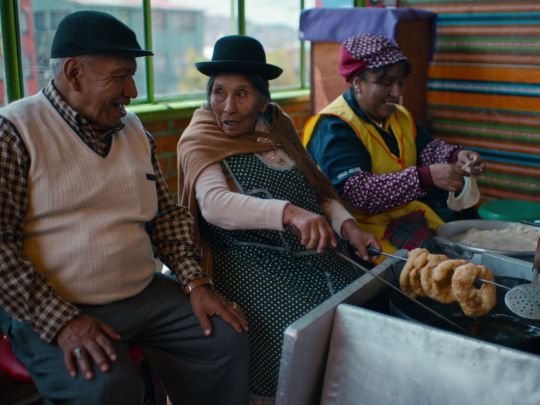
Netflix/Street Food: Latin America
From the Editor: Everything you missed in food news last week
This post originally appeared on July 18, 2020 in Amanda Kludt’s newsletter “From the Editor,” a roundup of the most vital news and stories in the food world each week. Read the archives and subscribe now.
I have a weekend binge recommendation for you when you’re done watching I May Destroy You. It’s the Latin American edition of Netflix doc series Street Food. Focusing on the work of a mostly female cast of street vendors around Latin American cities, it features beautiful dishes, vibrant food scenes, and stories of true grit and endurance.
I can’t decide if the reliance on characters that had to overcome tragedy and trauma — homelessness, unwanted pregnancy, domestic violence — via bootstrapping a food business is slightly lazy and a little opportunistic or just the unfortunate reality for the majority of women in the position of selling street food. (The exception seems to be the Baianas in Salvador, who are treated like goddesses.) Regardless, I appreciate the creators applying the same cinematic grandeur and narrative hagiography to street vendors that they long applied to the mostly white, male, English-speaking chefs in their famous series Chef’s Table.
And as my former colleague wrote of the first season, the inclusion of multiple vendors in each episode to show how the main figure fits into a broader scene coupled with the shortened run time make for a livlier show. The group of creators still has a ways to go in terms of representation behind the scenes, but I appreciate a woman directed half of the season.
Read more about the line up in Jaya’s full review.
On Eater
— Closures: Guthrie’s in Chicago; Emeril Lagasse’s sports bar on the Las Vegas strip; The Banty Rooster in New York; and Pagliacci in Seattle.
— How restaurants in SF are redesigning their menus for outdoor dining.
— Reopening a restaurant during the pandemic is expensive. So is shutting it down again.
— The owners of Kuma’s Corner, Chicago’s famous heavy metal burger bar chain, apologized this week for toxic workplace culture.
— Seattle’s city council passed a law preventing landlords from seizing personal property of small business owners should they default on a commercial lease.
— A number of properties in Vegas didn’t shut down or follow contact tracing guidelines after employees tested positive for COVID-19, and the town’s powerful culinary union isn’t having it.
— Chef Zoe Adjonyoh’s use Nigella Lawson’s Instagram profile during a #sharethemicfoodandbev campaign was a reminder of the platform’s power to amplify voices.

Katsu Sando [Official Photo]
— Openings: Kokomo, a pan-Caribbean restaurant, Caravan, Manhattan’s first Uighur restaurant, and Wicked Jane, an unapologetically high-end spot, in New York; Katsu Sando, a hotly anticipated sandwich shop inspired by Japanese convenience stores, and MILA, a delivery-only taqueria from Ray Garcia, in LA; Reckon, a friend chicken spot, in Portland; and Nixta, a tortilleria offering family-style take-out dinners, in Minneapolis.
— New York’s trendy restaurants are now booked two weeks out.
— In the world of fun pivots: A Seattle bar owner is now serving Cambodian dishes inspired by his mom out of his former bar space, and people are loving it; meanwhile one of the fanciest restaurants in Chicago now has a conbini shop and tiki patio; and chef Erik Bruner-Yang turned his group of restaurants inside the Line Hotel in D.C. into a shop selling omurice and onigiri.
— A fun look at the Instagram-powered underground food scene in LA.
— Turns out the pandemic didn’t kill family-style dining and shareable small plates.
— Just make all your vacation food ahead of time and bring it.
— Watch: How the Meat Hook butcher shop is thriving during this time.
Off Eater
Writers and crew members’ anonymous reports on what it’s like to work on cop shows and procedurals says a lot about why representation is so terrible on TV. [Vulture]
A great look at the problems around naming recipes on the internet and what we lose when paratha is called “flaky bread.” [VICE]
I love this little story about a guy sailing around the world with his pet chicken. [Great Big Story]
A conversation about how to fix wine education and mentorship. [Punch]
from Eater - All https://ift.tt/2CJpnUo
https://ift.tt/2P1CHWs

Netflix/Street Food: Latin America
From the Editor: Everything you missed in food news last week
This post originally appeared on July 18, 2020 in Amanda Kludt’s newsletter “From the Editor,” a roundup of the most vital news and stories in the food world each week. Read the archives and subscribe now.
I have a weekend binge recommendation for you when you’re done watching I May Destroy You. It’s the Latin American edition of Netflix doc series Street Food. Focusing on the work of a mostly female cast of street vendors around Latin American cities, it features beautiful dishes, vibrant food scenes, and stories of true grit and endurance.
I can’t decide if the reliance on characters that had to overcome tragedy and trauma — homelessness, unwanted pregnancy, domestic violence — via bootstrapping a food business is slightly lazy and a little opportunistic or just the unfortunate reality for the majority of women in the position of selling street food. (The exception seems to be the Baianas in Salvador, who are treated like goddesses.) Regardless, I appreciate the creators applying the same cinematic grandeur and narrative hagiography to street vendors that they long applied to the mostly white, male, English-speaking chefs in their famous series Chef’s Table.
And as my former colleague wrote of the first season, the inclusion of multiple vendors in each episode to show how the main figure fits into a broader scene coupled with the shortened run time make for a livlier show. The group of creators still has a ways to go in terms of representation behind the scenes, but I appreciate a woman directed half of the season.
Read more about the line up in Jaya’s full review.
On Eater
— Closures: Guthrie’s in Chicago; Emeril Lagasse’s sports bar on the Las Vegas strip; The Banty Rooster in New York; and Pagliacci in Seattle.
— How restaurants in SF are redesigning their menus for outdoor dining.
— Reopening a restaurant during the pandemic is expensive. So is shutting it down again.
— The owners of Kuma’s Corner, Chicago’s famous heavy metal burger bar chain, apologized this week for toxic workplace culture.
— Seattle’s city council passed a law preventing landlords from seizing personal property of small business owners should they default on a commercial lease.
— A number of properties in Vegas didn’t shut down or follow contact tracing guidelines after employees tested positive for COVID-19, and the town’s powerful culinary union isn’t having it.
— Chef Zoe Adjonyoh’s use Nigella Lawson’s Instagram profile during a #sharethemicfoodandbev campaign was a reminder of the platform’s power to amplify voices.

Katsu Sando [Official Photo]
— Openings: Kokomo, a pan-Caribbean restaurant, Caravan, Manhattan’s first Uighur restaurant, and Wicked Jane, an unapologetically high-end spot, in New York; Katsu Sando, a hotly anticipated sandwich shop inspired by Japanese convenience stores, and MILA, a delivery-only taqueria from Ray Garcia, in LA; Reckon, a friend chicken spot, in Portland; and Nixta, a tortilleria offering family-style take-out dinners, in Minneapolis.
— New York’s trendy restaurants are now booked two weeks out.
— In the world of fun pivots: A Seattle bar owner is now serving Cambodian dishes inspired by his mom out of his former bar space, and people are loving it; meanwhile one of the fanciest restaurants in Chicago now has a conbini shop and tiki patio; and chef Erik Bruner-Yang turned his group of restaurants inside the Line Hotel in D.C. into a shop selling omurice and onigiri.
— A fun look at the Instagram-powered underground food scene in LA.
— Turns out the pandemic didn’t kill family-style dining and shareable small plates.
— Just make all your vacation food ahead of time and bring it.
— Watch: How the Meat Hook butcher shop is thriving during this time.
Off Eater
Writers and crew members’ anonymous reports on what it’s like to work on cop shows and procedurals says a lot about why representation is so terrible on TV. [Vulture]
A great look at the problems around naming recipes on the internet and what we lose when paratha is called “flaky bread.” [VICE]
I love this little story about a guy sailing around the world with his pet chicken. [Great Big Story]
A conversation about how to fix wine education and mentorship. [Punch]
from Eater - All https://ift.tt/2CJpnUo
via Blogger https://ift.tt/2X0Sppm
0 notes
Text
The Best Seasons of HBO’s The Wire (Ranked)
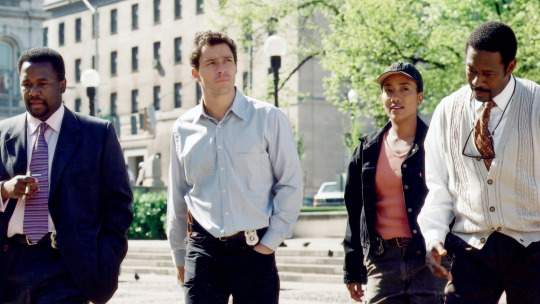
Written By Malik G.
Introduction
What can I say about HBO’s The Wire that hasn’t already been said? Arguably one of the greatest TV shows ever made, The Wire provided audiences with an in-depth look into the city of Baltimore through its various institutions, establishments, and citizens. On the surface, The Wire is a simple story about police officers vs drug dealers but on another level, it’s an analysis of how people come together and interact when placed in a densely populated area.
The Wire could’ve easily taken place in New York, Philly, or Chicago but given how familiarized the creators David Simon and Ed Burns were with Baltimore – one being a Baltimore Sun journalist, the other being a homicide detective – there was no better backdrop. What separated The Wire from other police procedurals like NYPD Blue and Law & Order was its serialized nature. Each episode wasn’t its own case but rather a chapter in the overarching story that is the war on drugs.
Throughout the series, we examined the great American city through the eyes of cops, lawyers, politicians, drug dealers, and even the working class as each season introduced us to a new institution and how it either combats or perpetuates criminality. I could literally go on about The Wire forever (just ask my friends and family). However, I’m here to talk about its five seasons and which had the greatest impact on me as well storytelling and entertainment overall.
Check out where I ranked each season of HBO’s The Wire
Number 5: Season 2 (AKA The One That Left Everyone Confused)
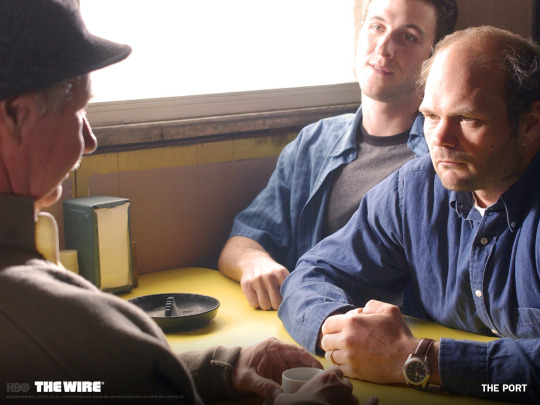
On the first watch, I hated everything about season two of The Wire, mostly due to my lingering questions. Why were we focusing on a bunch of stevedores? What’s with this mysterious Greek character? Is McNulty going to be on marine patrol the entire time? What does any of this have to do with the Barksdale organization? By the time season two had ended, it had garnered my attention but I was still happy to be moving on.
Many distinguish the second season of The Wire as the weakest, mostly because of its 180° shift in terms of focus and narrative. The Major Crimes Unit has been disbanded, McNulty is riding the boat, Stringer Bell is in charge of the Barksdale organization while Avon and Deangelo are locked up, and something fishy is going on at the docks. As unnecessary as many people view season two, in retrospect, it might just be the most significant. While I feel we could’ve done without the mystery of the dead container girls, it was important to know just where the drugs were coming from.
Even though the Avon and Deangelo storyline got pushed back to the second tier, it did provide us with one of the show’s most heartbreaking deaths. Season two might’ve felt like a chore to slog through but on second and third watch, it proves that it belongs right next to the others in regards to character development and storytelling. Also, it gave us the Omar Little vs Lawyer courtroom scene, which is a must-see for anybody that questions how the legal system truly operates.
Number 4: Season 5 (AKA The One That Ended It All)

The series finale of The Wire is probably my all-time favorite next to Breaking Bad. It showed that even though the show was coming to an end, the so-called Game never stops. Drug lord Marlo Stanfield was forced into retirement, McNulty and Freamon were fired from the police force, and Michael and Dukie fit into their roles as the new Omar and Bubbles respectively.
However, season five wasn’t about giving its characters the send off they deserved but rather showing us how the cycle always finds a way to reset itself. The war on drugs could never be won because no one really understands how it operates or where it originated. There will always be another drug lord, cop, and politician to ensure that the drug trade has its highs and lows.
But, onto the season as a whole. The Wire has received critical acclaim for its immense level of realism. That being said, imagine my disappointment when I discovered the primary storyline for the final season. It would revolve around McNulty creating a fake serial killer so that the mayor would grant funds to the police department that McNulty would then funnel into a terminated drug case.
Now, don’t get me wrong. Season five was highly entertaining and superbly written but its premise was just too far-fetched for me to get behind. Also the most action-packed, season five gave us a Marlo vs Omar showdown, which seemed promising only to end rather anticlimactically. I love the final season for wrapping up the series in the most creative way possible but unfortunately, its semi-unbelievable concept forces me to place it at the number four spot.
Number 3: Season 1 (AKA The One That Started It All)

I still remember the first time watching The Wire. I had just finished binge watching Breaking Bad and was in need of something equally as captivating. Searching through my HBO Go, I came across The Wire and the rest was history. Despite initially finding it boring and convoluted, I quickly became invested in its characters and overall narrative.
Similar to Game of Thrones, I didn’t know what was going on but I was eager to discover what was going to happen next. What really captured my attention was the amount of time that the show dedicated to developing both sides of the conflict. This might sound crazy but season one showed us that there are such things as bad cops and good criminals because, at the end of the day, we’re all people.
The Wire’s freshman season also presented us with so many memorable moments like Kima getting shot, the death of Wallace, and Deangelo’s change of heart. Season one also did a wonderful job at telling a self-contained story so if they weren’t renewed, the audience would be given with an appropriate amount of closure. The Wire provided the perfect template for how a premiere season should be developed with many shows following the formula to this day.
Number 2: Season 3 (AKA The One That Shocked And Awed)
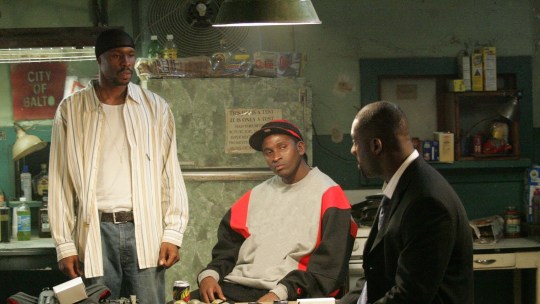
If season two took a detour through the docks and lives of the working class in Baltimore then season three was a delightful return to form. We found ourselves back on the Westside corners and wow was it mesmerizing. Avon, Stringer, and the Barksdale organization were back in business and this time they were going up against newcomer Marlo Stanfield.
Season three gave us a turf war that proved no matter who wins, the city always loses. In addition to this, police Major Bunny Colvin conducts an experiment that attempts to regulate the drug trade rather than fight it – something quite similar to the dispute regarding prohibition. The Major Crimes unit was up and running in full force and Stringer Bell was the true target again.
Season three is great because it continued to give us more of what we loved while introducing a new institution in the form of local government. It presented us with the grim reality of politics and that everything, including the war on drugs, is fought with the goal of further an agenda.
Arguably the most daring of the five, season three was not afraid to make some risky decisions, killing off fan favorites and leaving viewers with a “what now” attitude. It was in season three where The Wire really found its footing and established itself as a mainstay in pop culture. I couldn’t get enough.
Number 1: Season 4 (AKA The One That Changed Everything)

Wow. Just wow. That was my reaction when finishing the fourth season of The Wire. I am going to go ahead and say that season four is the greatest season of television…Ever. After the events of the previous season, I was left wondering where the writers could possibly take the story next. Stringer Bell was dead, Avon was back in prison, McNulty had quit the Major Crimes unit to become a beat cop, and Marlo had become the new king of the streets.
Well, The Wire decided to pull another 180 and this time it was executed to glorious effect. We were introduced to the corner boys and their equally diverse and magnetic personalities. Namond, Randy, Michael, and Dukie – Season four showed us the Baltimore drug trade through their eyes and how it trickles down into the school system and their ability to receive an education. If season two showed audiences where the drugs came from, then season four revealed how the modern drug dealer is created.
It’s here where we discover where the Stringer Bells and Avon Barksdales of the world are made. There’s honestly just too much to talk about when it comes to season four. It’s easily the most tragic, enthralling, and introspective season of the series. When we weren’t watching the four main kids combat the struggles of life on the Westside, we got a glimpse of a happy McNulty, a ruthless and murderous Marlo Stanfield (Chris & Snoop = scariest henchmen ever), and how politicians are just as much of a problem as they are a possible solution.
I once spoke with a teacher who said she couldn’t finish the season because of how real and heartbreaking its depiction of education in a lower-class neighborhood was – yeah, it’s that serious. If you never watch another season of TV, watch season four of The Wire aka the one that changed everything.
Conclusion
There’s just so much more to talk about but feel I like I’ve overstayed my welcome. The Wire is a seminal piece of television that is being taught and studied almost a decade after its initial run. The definition of re-watchable, each time you enter the world of The Wire, there will always be something new to pick apart and analyze. If you haven’t yet seen The Wire, sorry for the spoilers but go watch it immediately. For everyone else, let me know how you felt about the popular HBO series in the comments below.
1 note
·
View note
Text
on Stupidity
I just watched Idiocracy, and I’m not sure what to make of it. It’s a satirical movie that depicts the United States 1000 years from now; it criticizes an American culture that values entertainment over intelligence, but it’s a very entertaining movie with a plot that doesn’t make you think very hard. Maybe that’s the point. Maybe we, as the audience, are prompted to situate ourselves in the fictional timeline. Maybe the movie itself is presented as consumable media, and only a more careful viewer can see the irony and peel back the layers. What are we left with, if we interpret it that way? Hopelessness.
I think of the movie as a parody of dystopian texts like Fahrenheit 451, but I wouldn’t call the characters in that novel stupid, per se. They’re very distracted, and they’re obsessed with violence, and they don’t want to think very hard about things that bother them when there are more entertaining acts that can be done in an instant. Fahrenheit 451 is dead serious and Idiocracy is a comedy, but they both point to a legitimate concern:
At this point in American history, many people are concerned that politics is being reduced to spectacle. Without revealing too much about Fahrenheit 451, the characters slowly realize that their media creates narratives. There is little regard for the truth, and for the nuances of the truth--they just want to entertain people with a good story.
We may be getting there. We may be reaching a point where we’re more concerned with digestible narratives than with the complexity of real issues. My favorite YouTube channel, Wisecrack, argues that politics is now more focused on personality and entertainment value than with real facts and real issues.
But personally, I’m more optimistic than that. We may be headed that way, but it also seems that intelligence is really valued in our generation, and that intelligent people are not mistreated. More importantly, the means are there. We can stream lectures on signal processing from India, download slides on European literature from France. We can discuss, share, debate. We have access to a ridiculous amount of information, and the hard part is knowing how to navigate through it without being overwhelmed.
You don’t draw a line through intelligence and stupidity. There isn’t a binary. I think that same logic applies here. We can’t simply say that our country is getting smarter, or stupider, under the basis of what assessments may show; we’re not allowed to have that notion of such simple closure, and we should challenge ourselves to see the nuances here.
2 notes
·
View notes